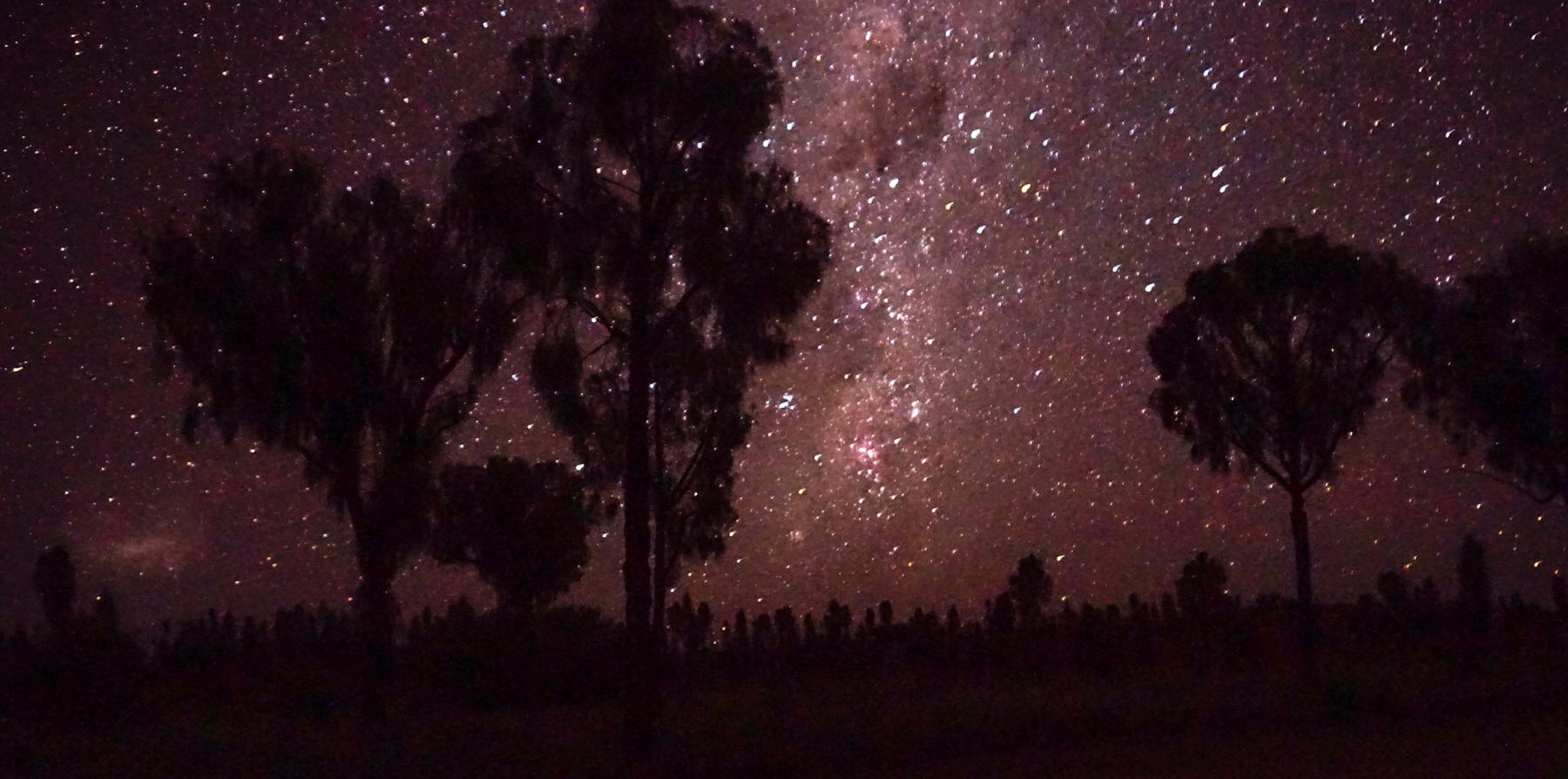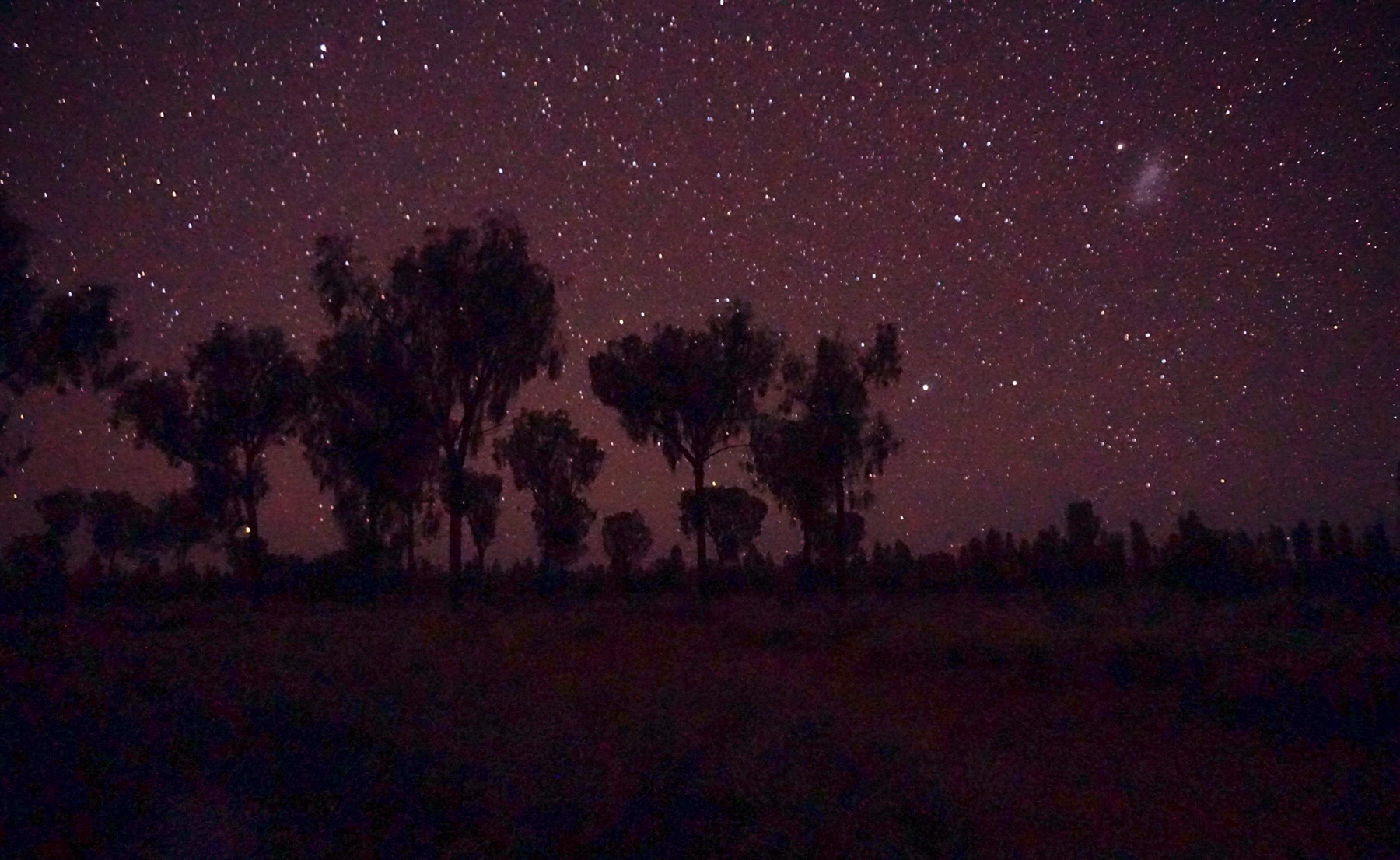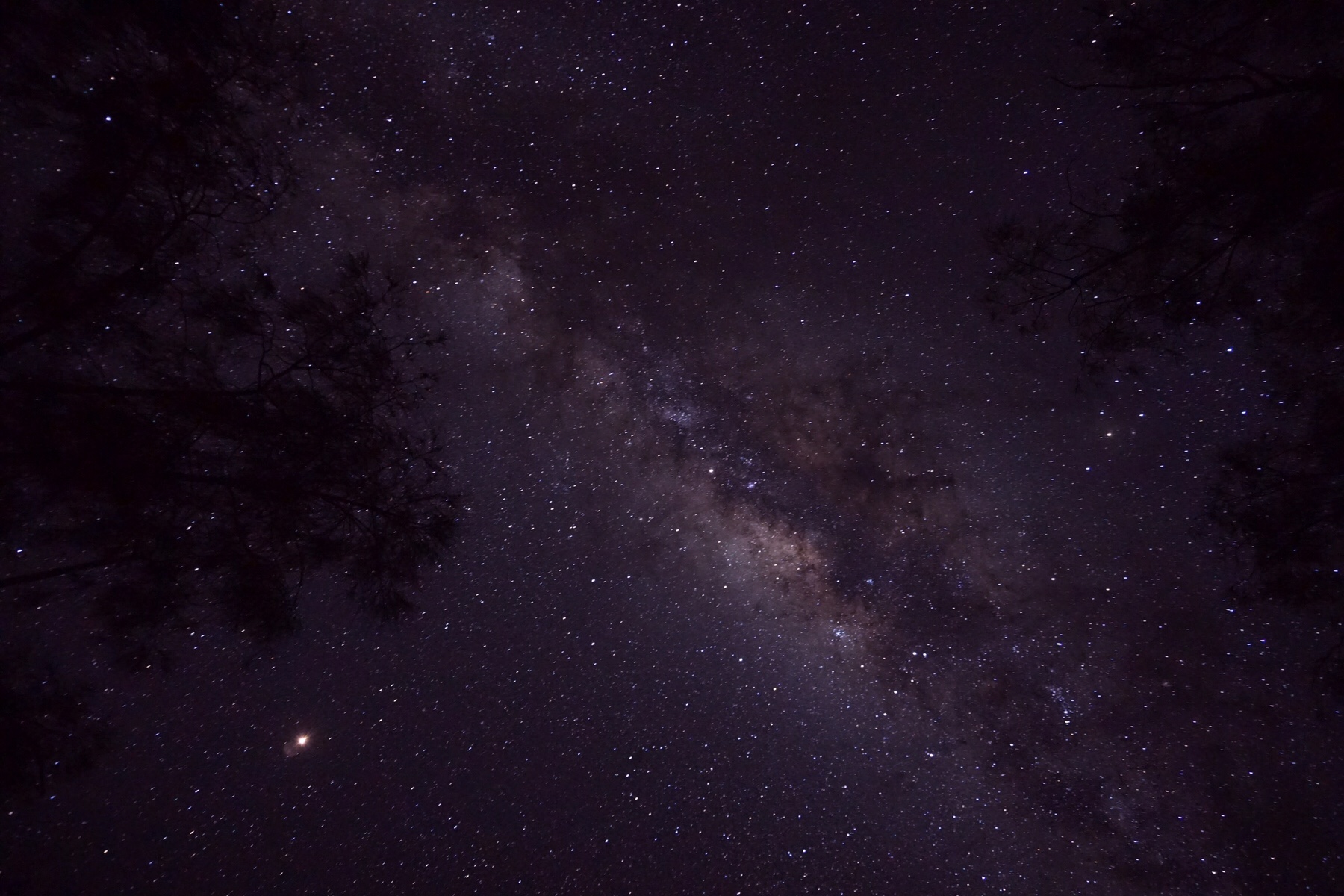Author: Mrs A
Location: Ormiston Gorge & back to Alice Springs
Saturday: Leaving our picturesque camp at Redbank Gorge, we drove a short way to Orminston Gorge along the Western MacDonnell Range towards Alice Springs. We parked up and got dressed up to do a hike.
It was a chilly morning – around 9 degrees with a cold wind which cut through your clothes. It just amazes us how it can go from 29 degrees yesterday to a top of about 15 degrees today!
We’d decided to do the Ormiston Pound hike, a walk that takes you into a spectacular flood plain surrounded by high red walls. We’d done the walk when we visited here years ago, and remembered the awe inspiring scenery we came across.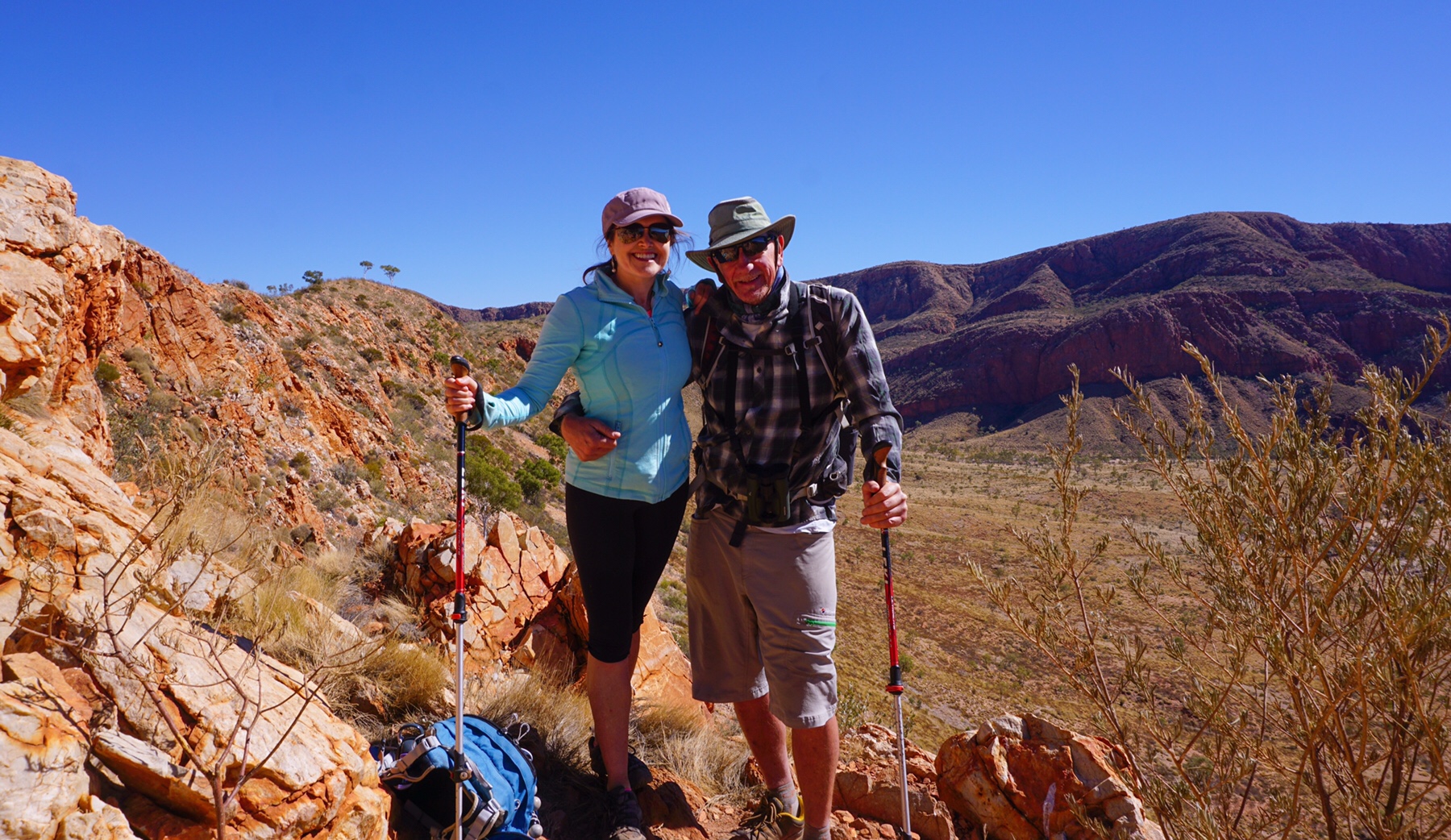
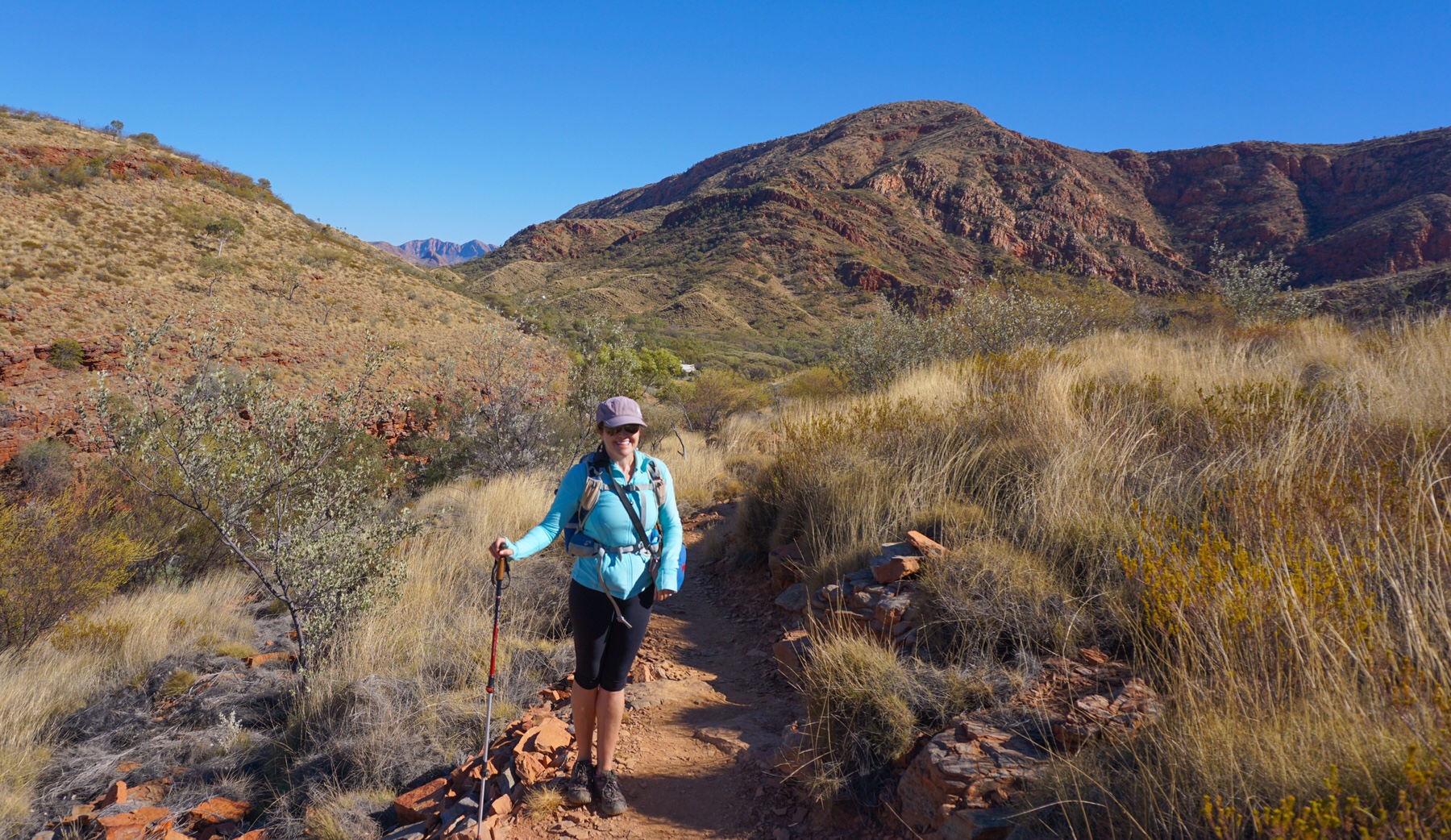
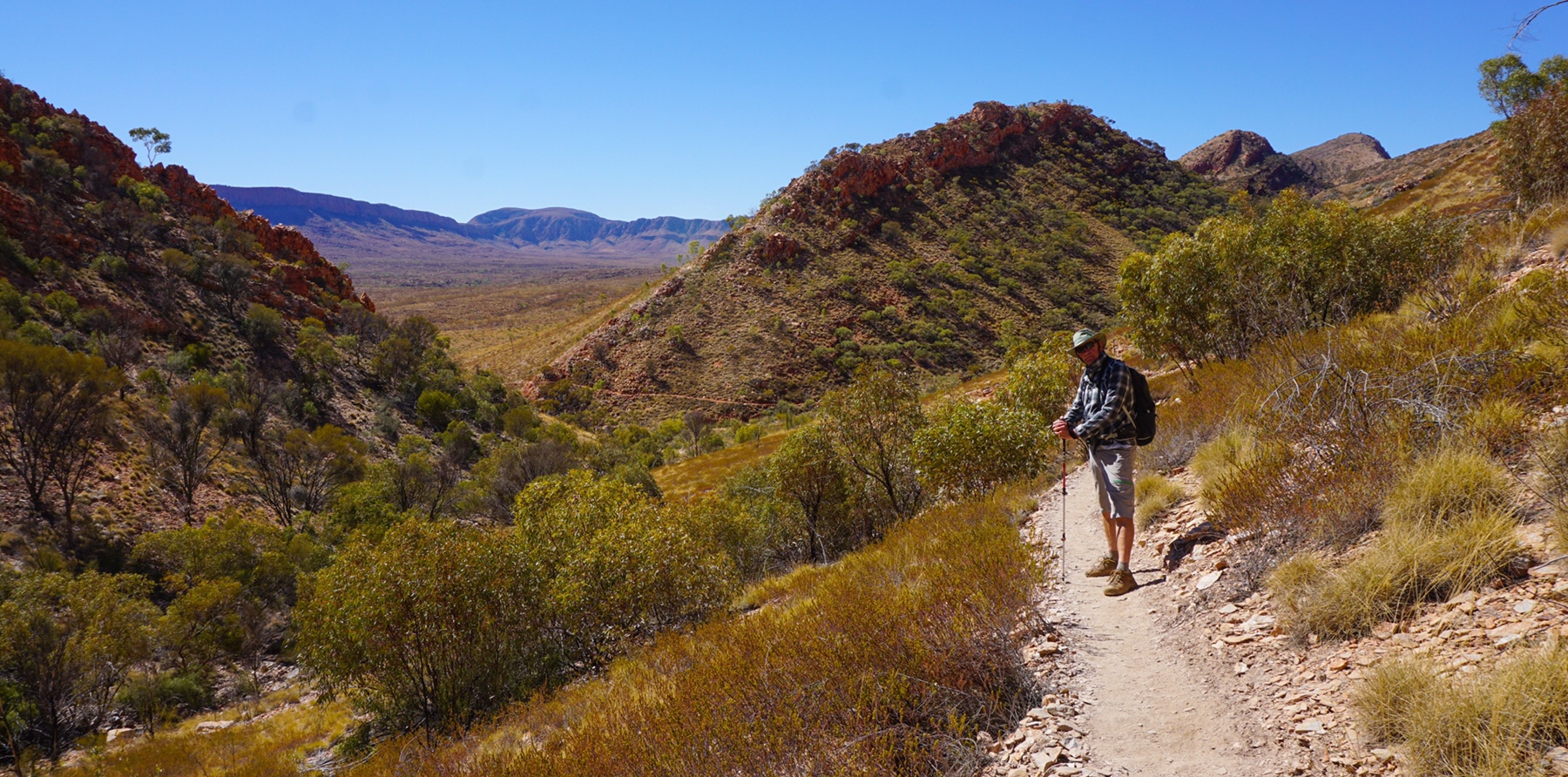 The circuit takes you firstly high up onto the walls of the Pound for spectacular views, before dropping down and winding its way across to a dry river bed, where you rock hop back to the beginning via some permanent water holes – like gold dust in this arid landscape.
The circuit takes you firstly high up onto the walls of the Pound for spectacular views, before dropping down and winding its way across to a dry river bed, where you rock hop back to the beginning via some permanent water holes – like gold dust in this arid landscape.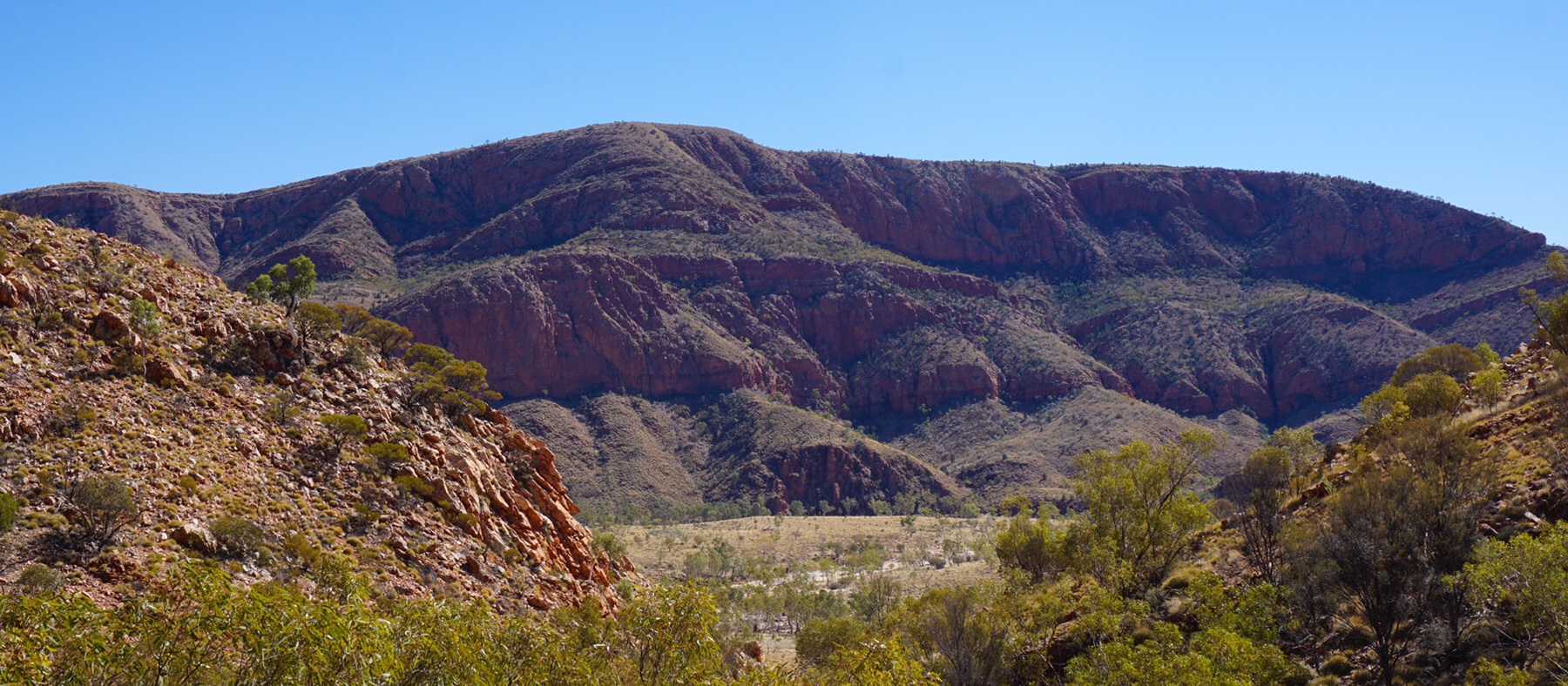
 The colours are so vivid in this incredible air, not polluted by traffic or smoke.
The colours are so vivid in this incredible air, not polluted by traffic or smoke.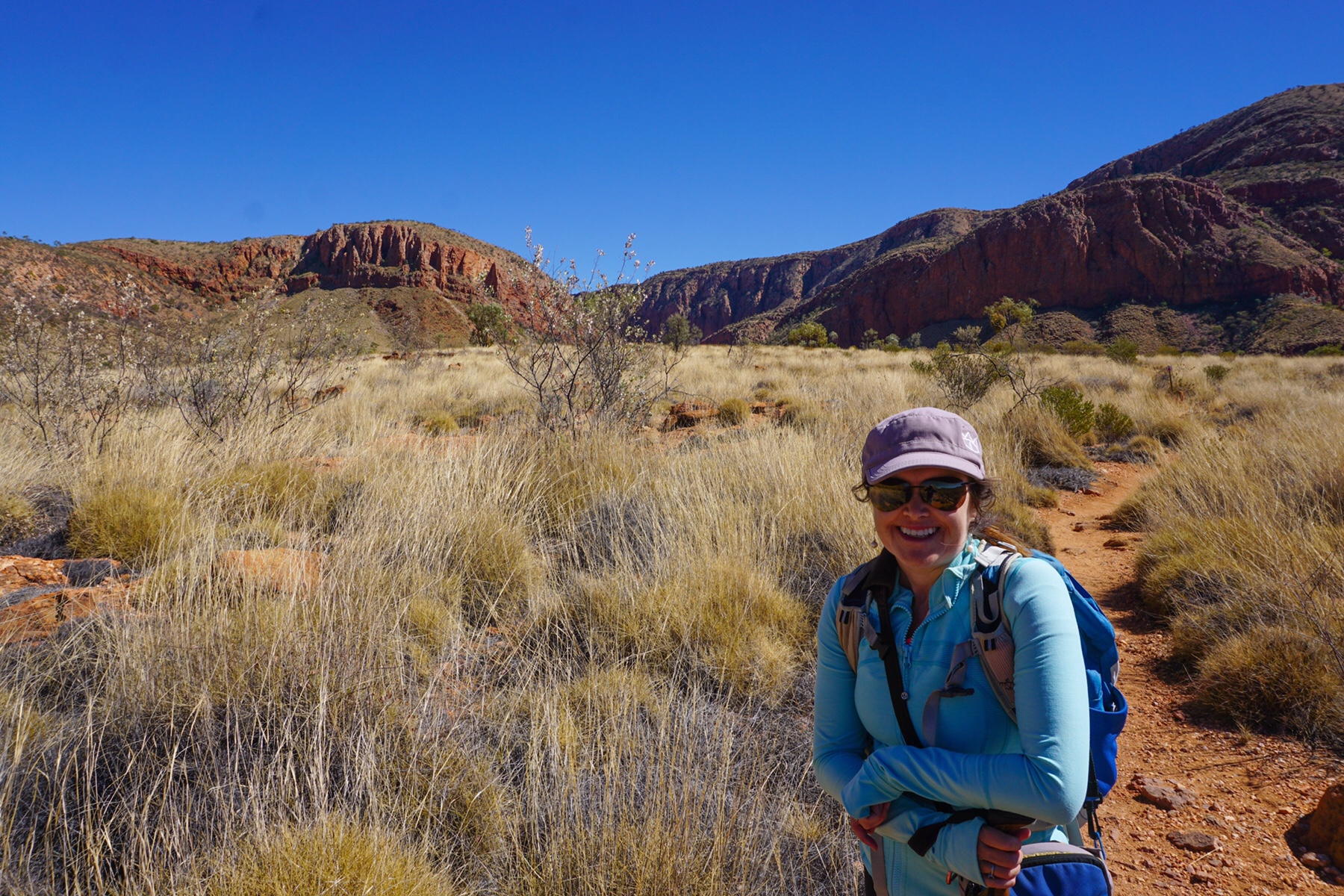
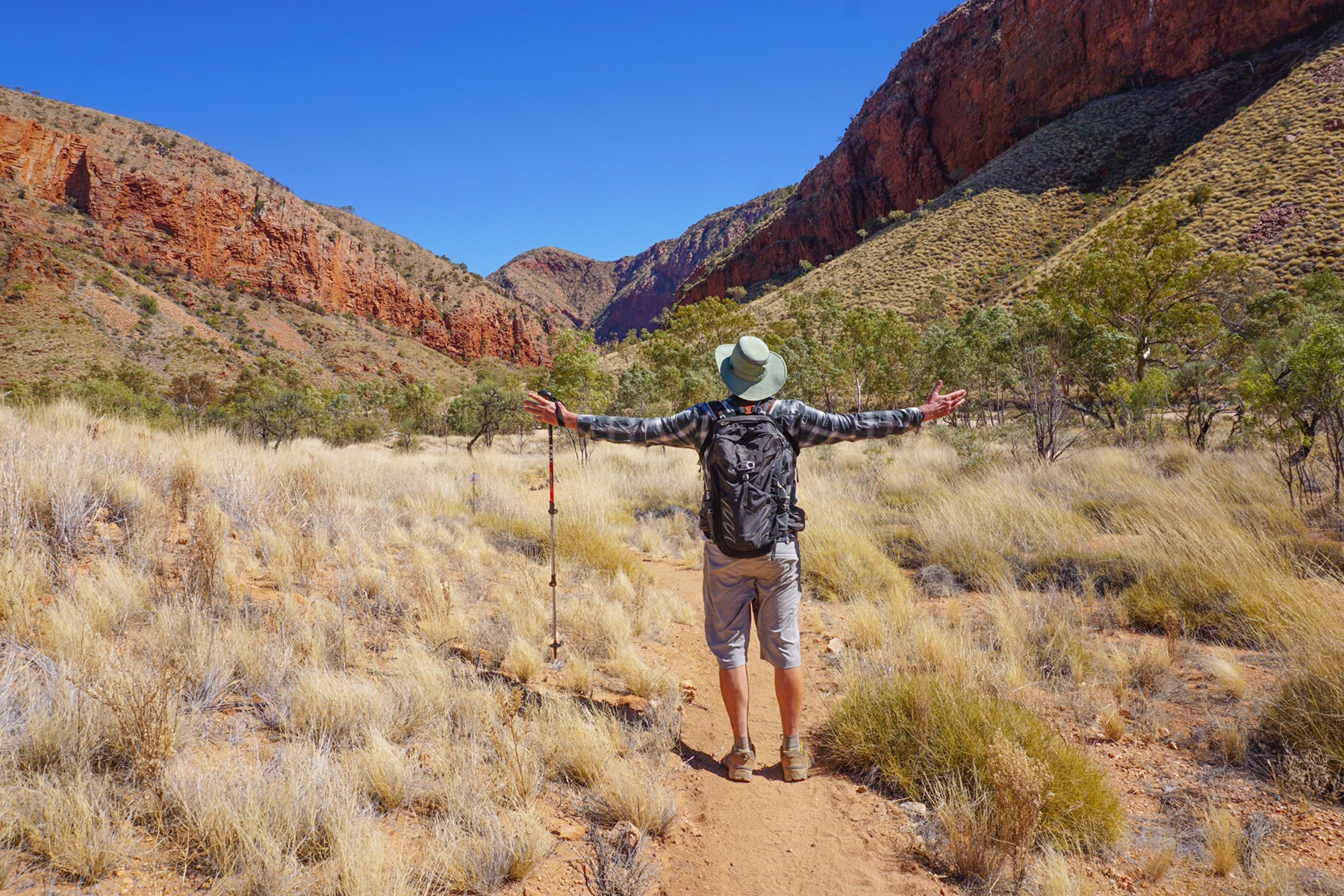 As the walls begin to close in on you for the last couple of kilometres you begin to appreciate the beauty of the rocks, not just the ochres, reds and salmons, but also yellows, mauves, purples and much much more. As the sunlight hits the walls above you it reflects into the shadows, creating more colour still – an absolute feast for the eyes. Even Mark’s limited visual palette was amazed.
As the walls begin to close in on you for the last couple of kilometres you begin to appreciate the beauty of the rocks, not just the ochres, reds and salmons, but also yellows, mauves, purples and much much more. As the sunlight hits the walls above you it reflects into the shadows, creating more colour still – an absolute feast for the eyes. Even Mark’s limited visual palette was amazed.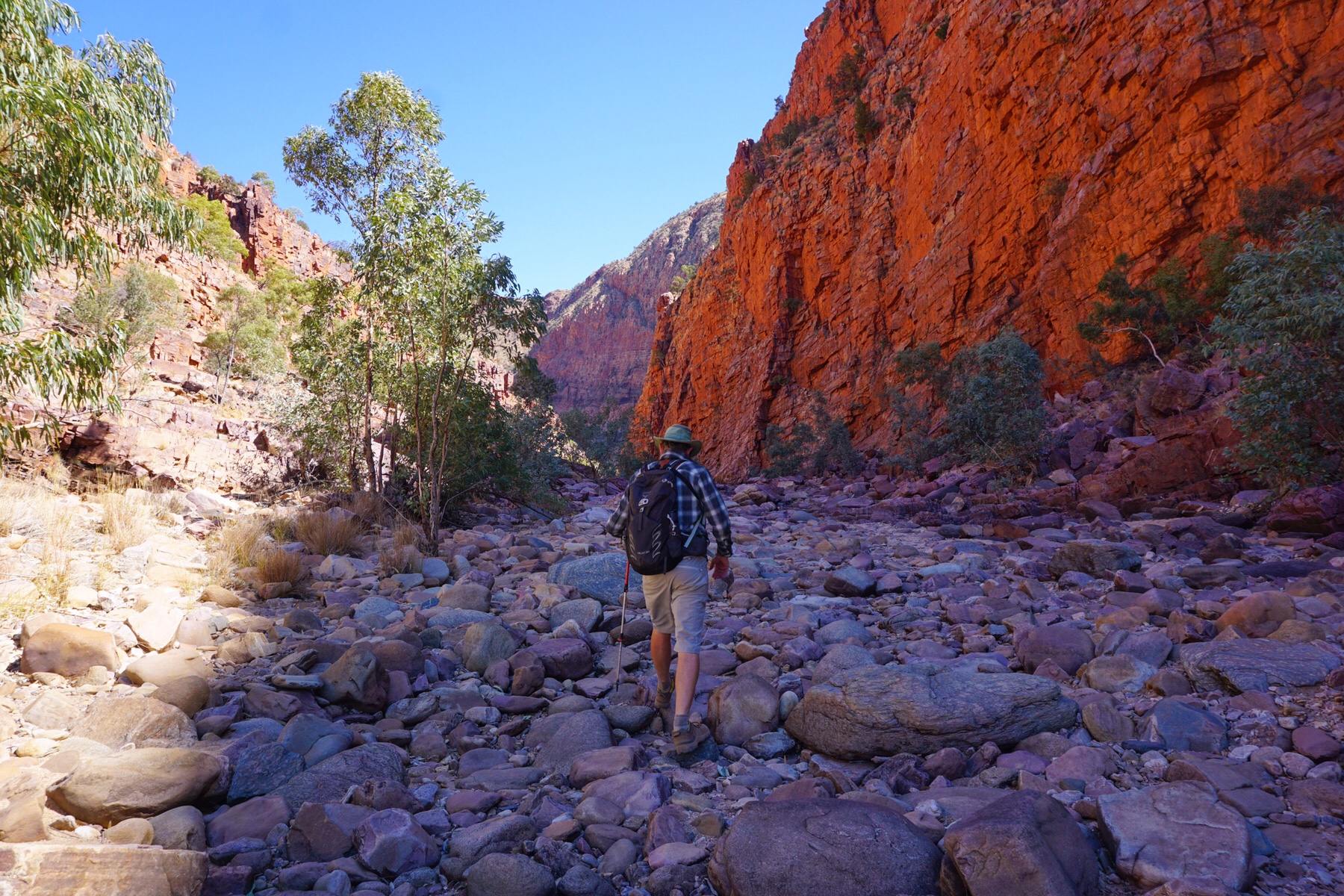
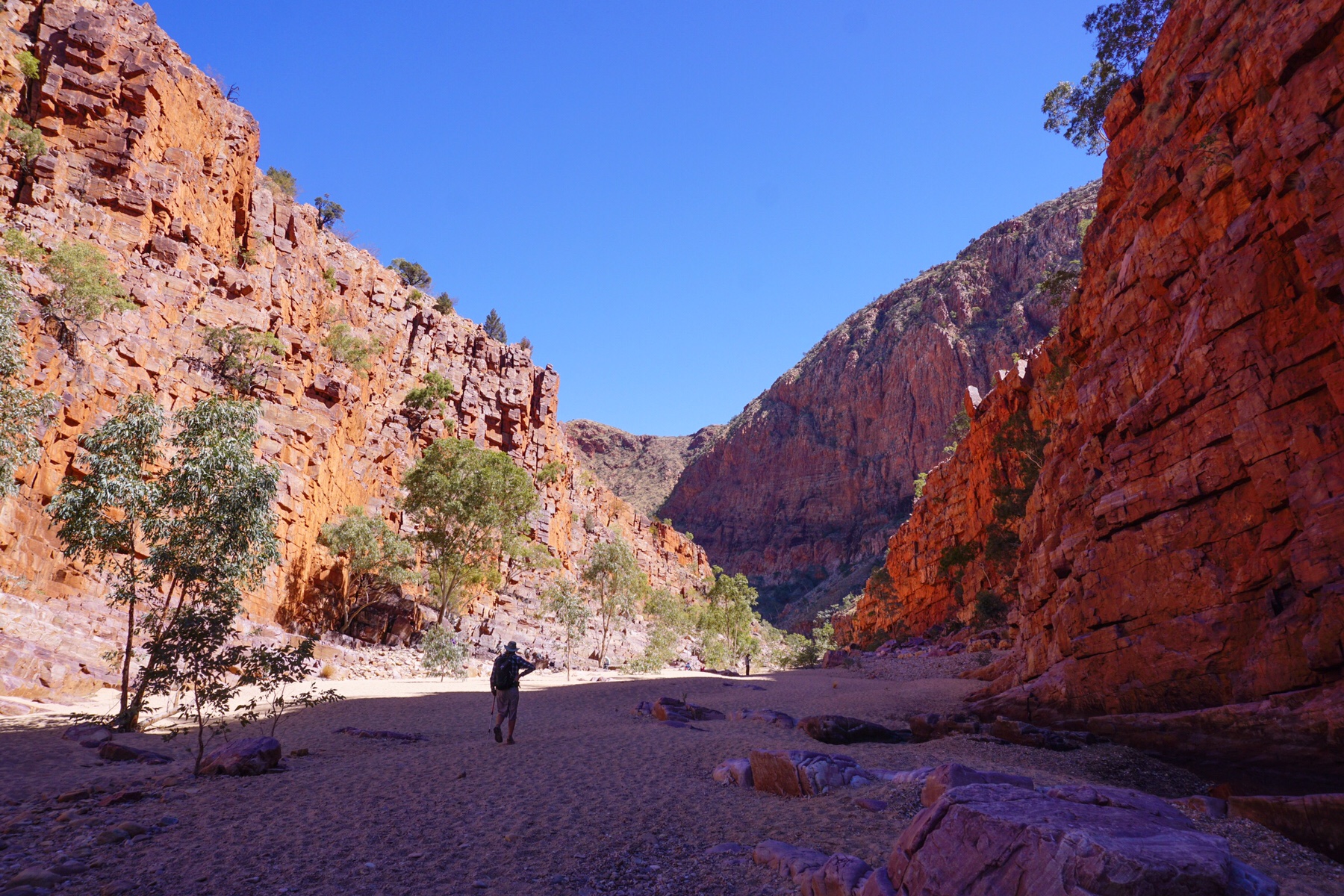 We finished by walking past the waterholes – we recall that last time we were here we had seen some endangered yellow footed rock wallabies drinking here, but this time it was a little too busy for these shy creatures.
We finished by walking past the waterholes – we recall that last time we were here we had seen some endangered yellow footed rock wallabies drinking here, but this time it was a little too busy for these shy creatures.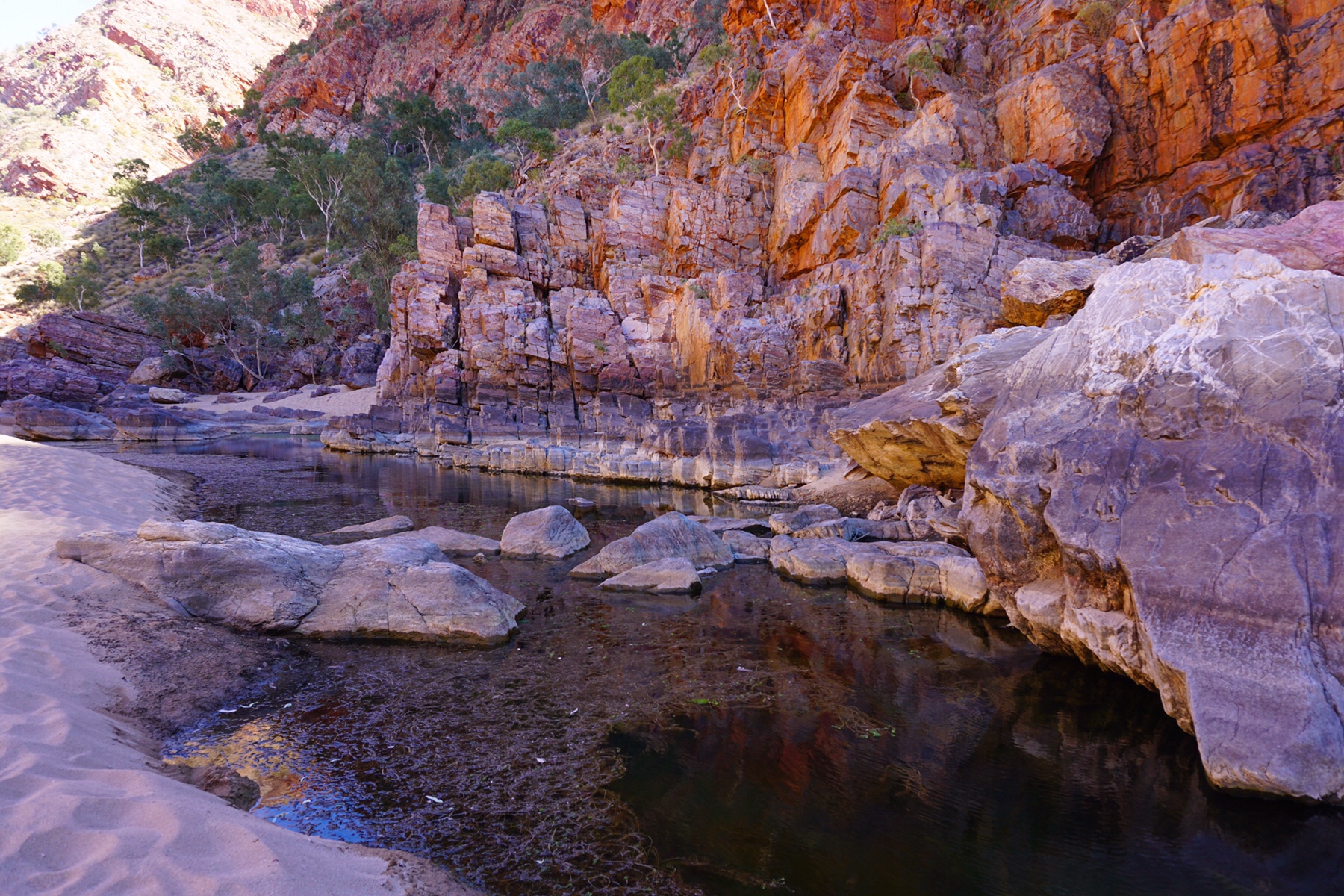
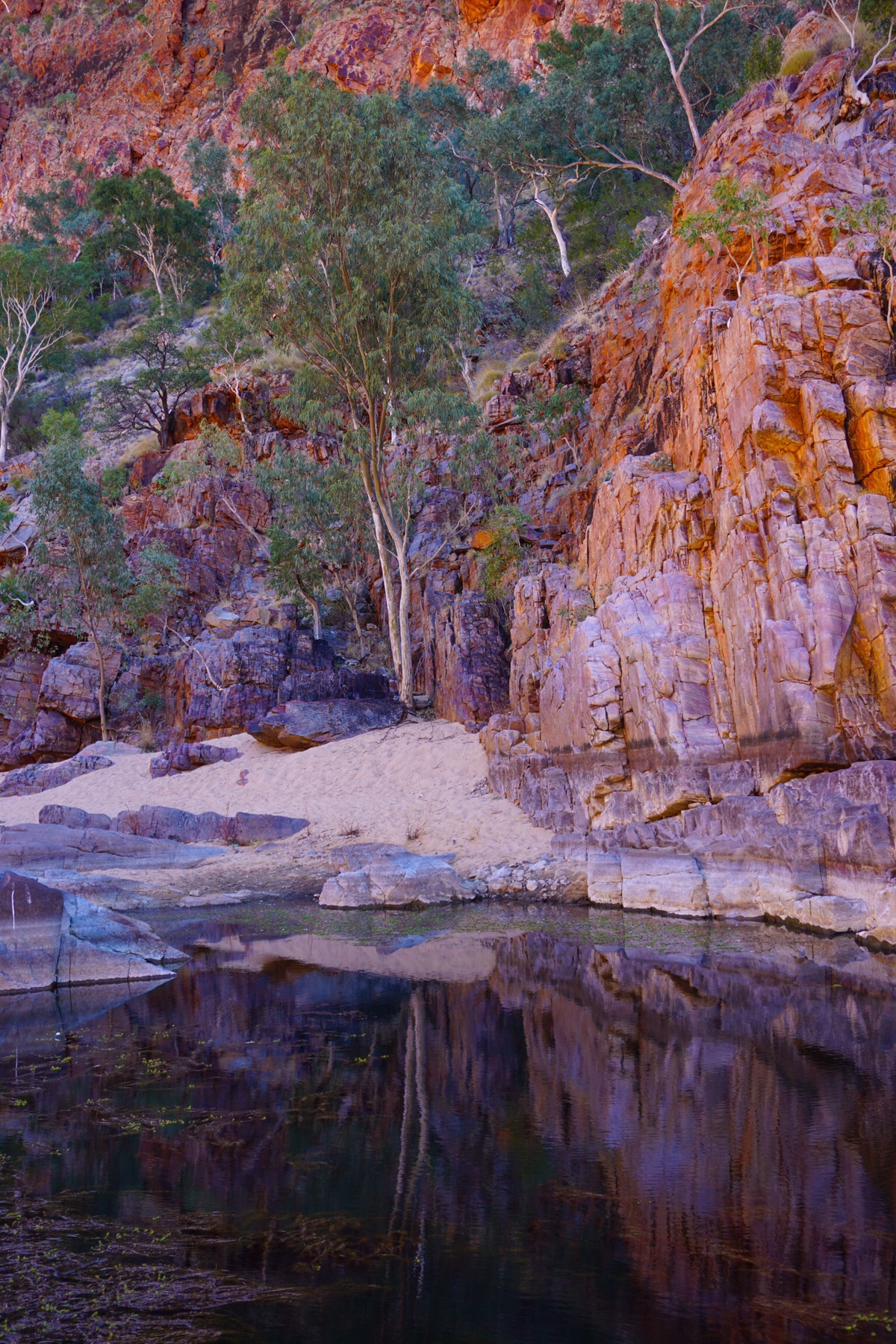 The final green waterhole is apparently suitable for swimming – though any thoughts of diving into its icy depths were far from our minds as we walked past. It is home to ducks, white faced herons and darters, so definitely supports some aquatic life.
The final green waterhole is apparently suitable for swimming – though any thoughts of diving into its icy depths were far from our minds as we walked past. It is home to ducks, white faced herons and darters, so definitely supports some aquatic life.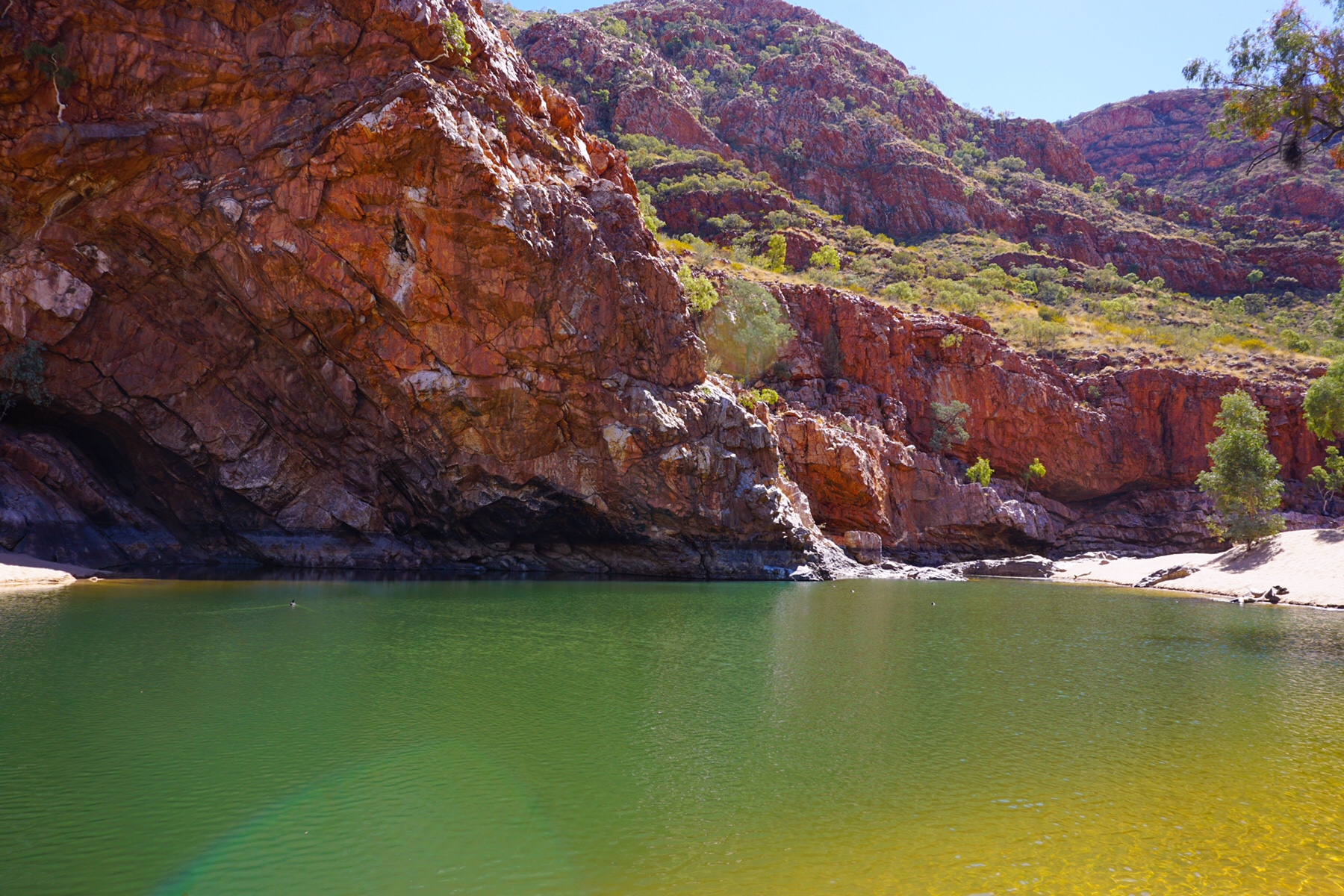 We concluded our 9km hike with a burger from the cafe on site – well deserved we thought!
We concluded our 9km hike with a burger from the cafe on site – well deserved we thought!
There are many more delights in the West MacDonnell Ranges we have not yet seen, plus the eastern ranges we are yet to visit. We will definitely have to be back. We have run out of time this trip.
After lunch we made our way back to Alice Springs – a little over 100km from this beautiful spot – and set up camp in a random tourist park we came across.
We had only been there seconds and a lady with a black dog came over and asked us how we liked our Zone. It turned out to be Wendy and Mel, fellow Zoners from Albury in southern NSW. After we had set up and showered, we popped over for drinks and to exchange travel stories.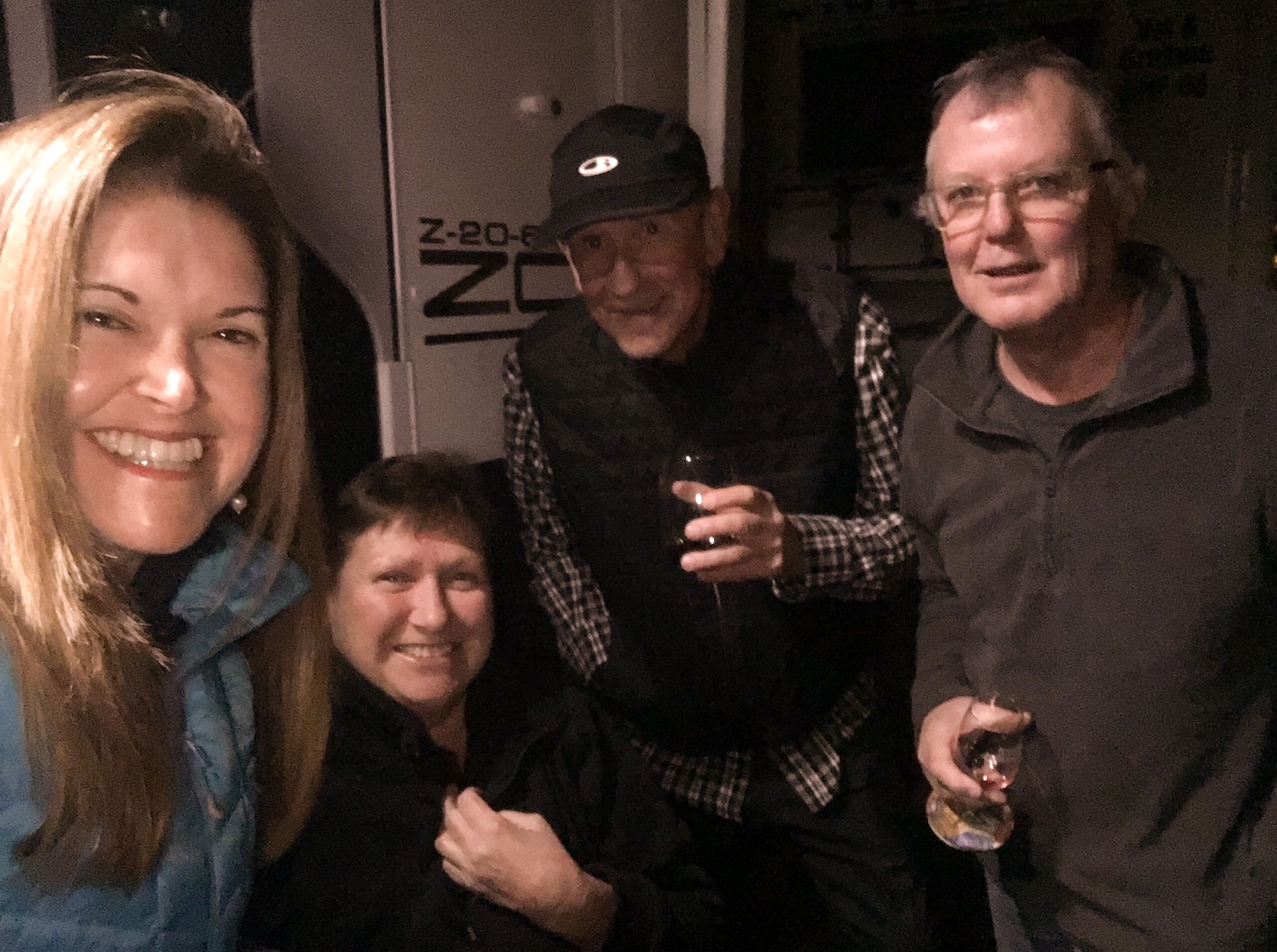 True to our experiences to date, yet more lovely Zoners.
True to our experiences to date, yet more lovely Zoners.
Sunday: We had originally planned to move on, but with a long list of tasks to do in Alice Springs before leaving made the decision to stop another night.
Tomorrow we commence our journey across the Plenty Highway, a remote and rough unpaved road which stretches across country into Queensland. There will be no phone signal or internet access, and we are planning to take four days to drive the route to Boulia. It’s 814km door to door, the first couple of hundred kilometres are tarmac, and then it gets slower and rougher.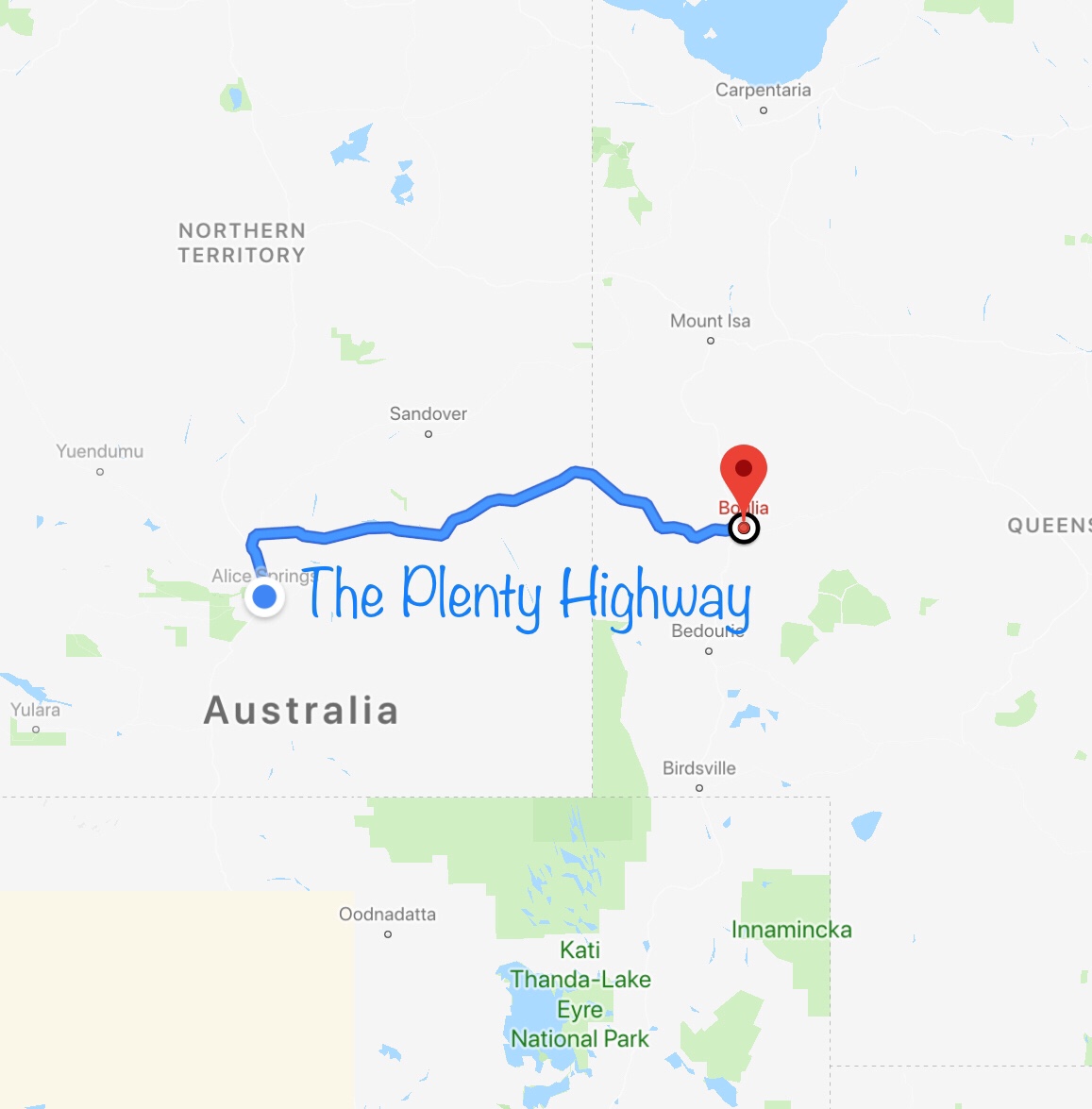 Hopefully we will be back on line by Friday to update you how it went!
Hopefully we will be back on line by Friday to update you how it went!
So, fresh fruit and vegetables purchased, spares and tools acquired, and online research into road conditions done, we are now as prepared as we can be.
We finished our day with a delicious Asian takeaway shared with Wendy and Mel and a couple of bottles of warming wine. Fabulous!


 By mid morning Google was estimating we were still over 2 hrs from our planned lunch stop, and then…a miracle. We come round a bend to see two graders ponderously chugging up the road towards us, leaving in their wake a lovely smooth surface!
By mid morning Google was estimating we were still over 2 hrs from our planned lunch stop, and then…a miracle. We come round a bend to see two graders ponderously chugging up the road towards us, leaving in their wake a lovely smooth surface!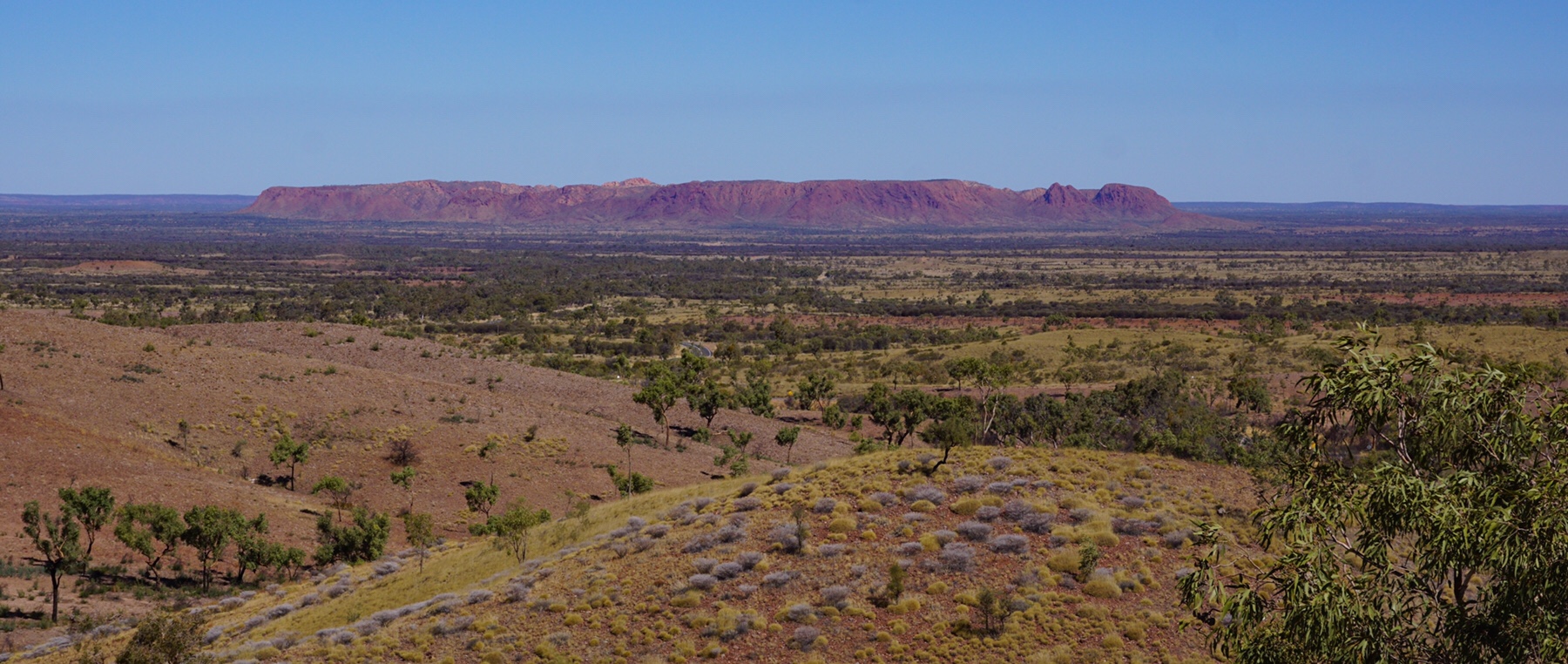 You wouldn’t have wanted to be around 400 million years ago when this bad baby hit earth. It was one of those views that we love in outback Australia – no sign of humans on the landscape for 360 degrees.
You wouldn’t have wanted to be around 400 million years ago when this bad baby hit earth. It was one of those views that we love in outback Australia – no sign of humans on the landscape for 360 degrees.
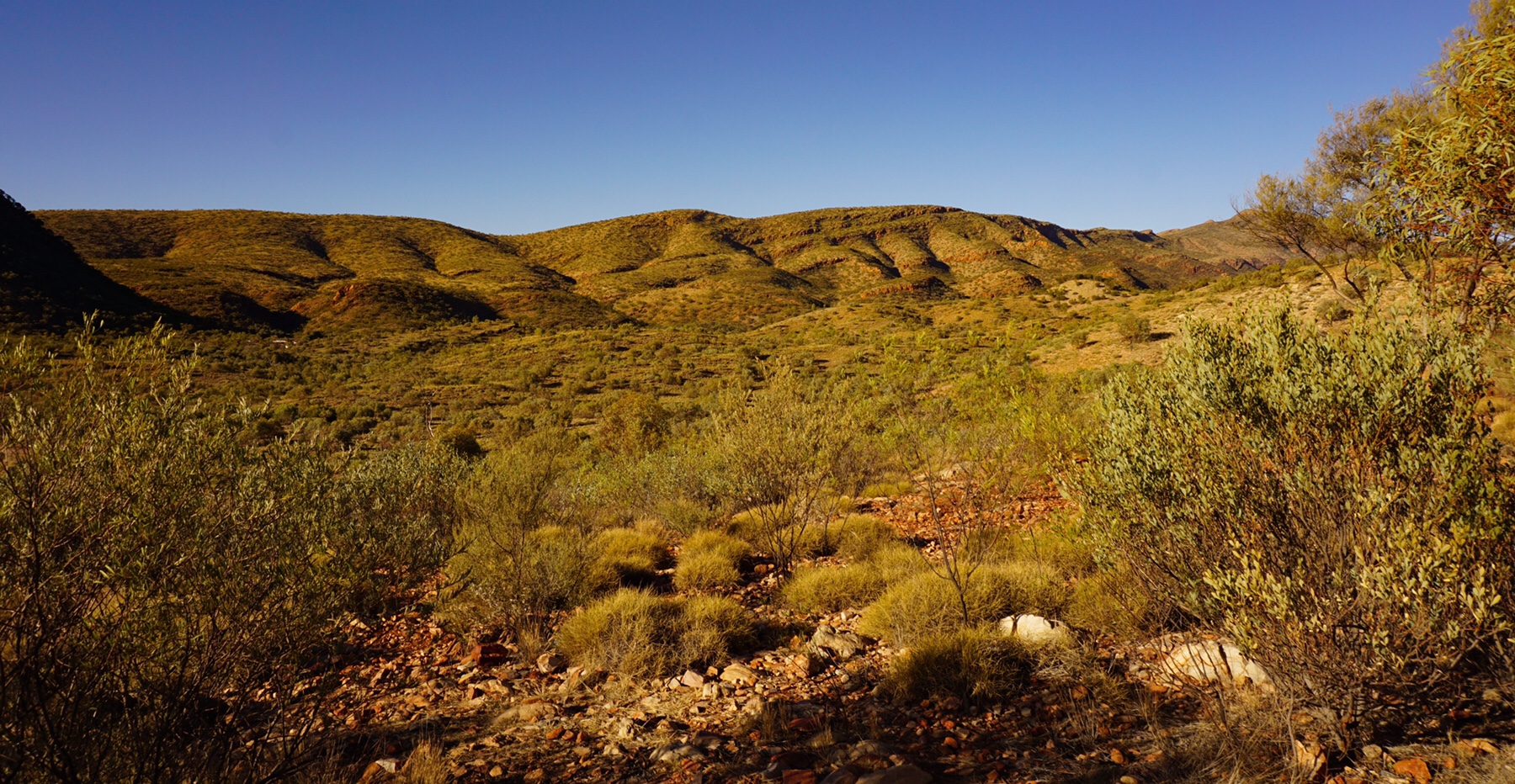 The Gorge is one of several in the West MacDonnell ranges, which spectacularly rise up out of the desert plain and stretch several hundred kilometres. We rocked up at was to be one of our prettiest campsites on this section of the trip, with views down into the gorge. We quickly unhitched and drove down the steep access road, parked up and hit the short trail into the gorge proper.
The Gorge is one of several in the West MacDonnell ranges, which spectacularly rise up out of the desert plain and stretch several hundred kilometres. We rocked up at was to be one of our prettiest campsites on this section of the trip, with views down into the gorge. We quickly unhitched and drove down the steep access road, parked up and hit the short trail into the gorge proper.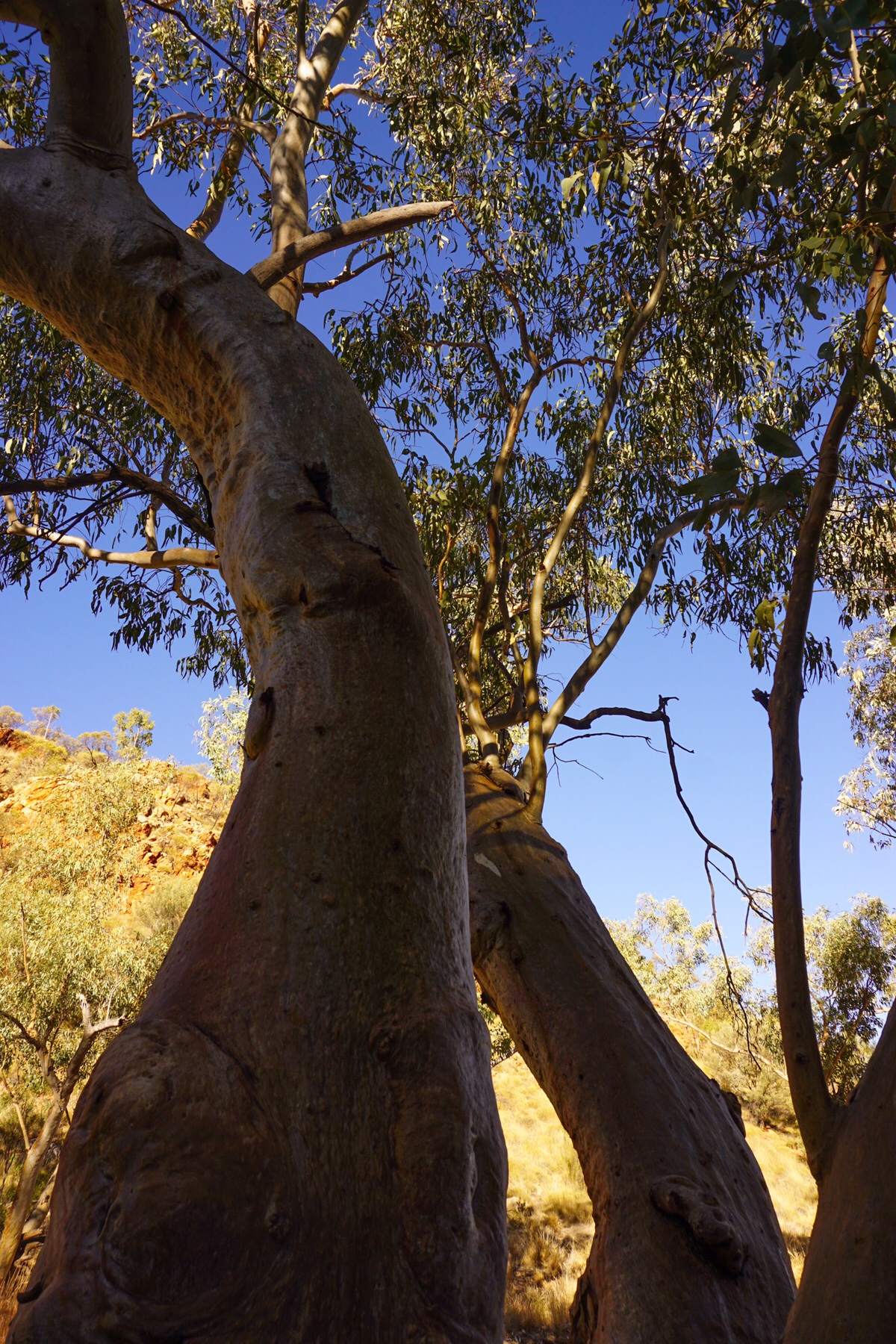
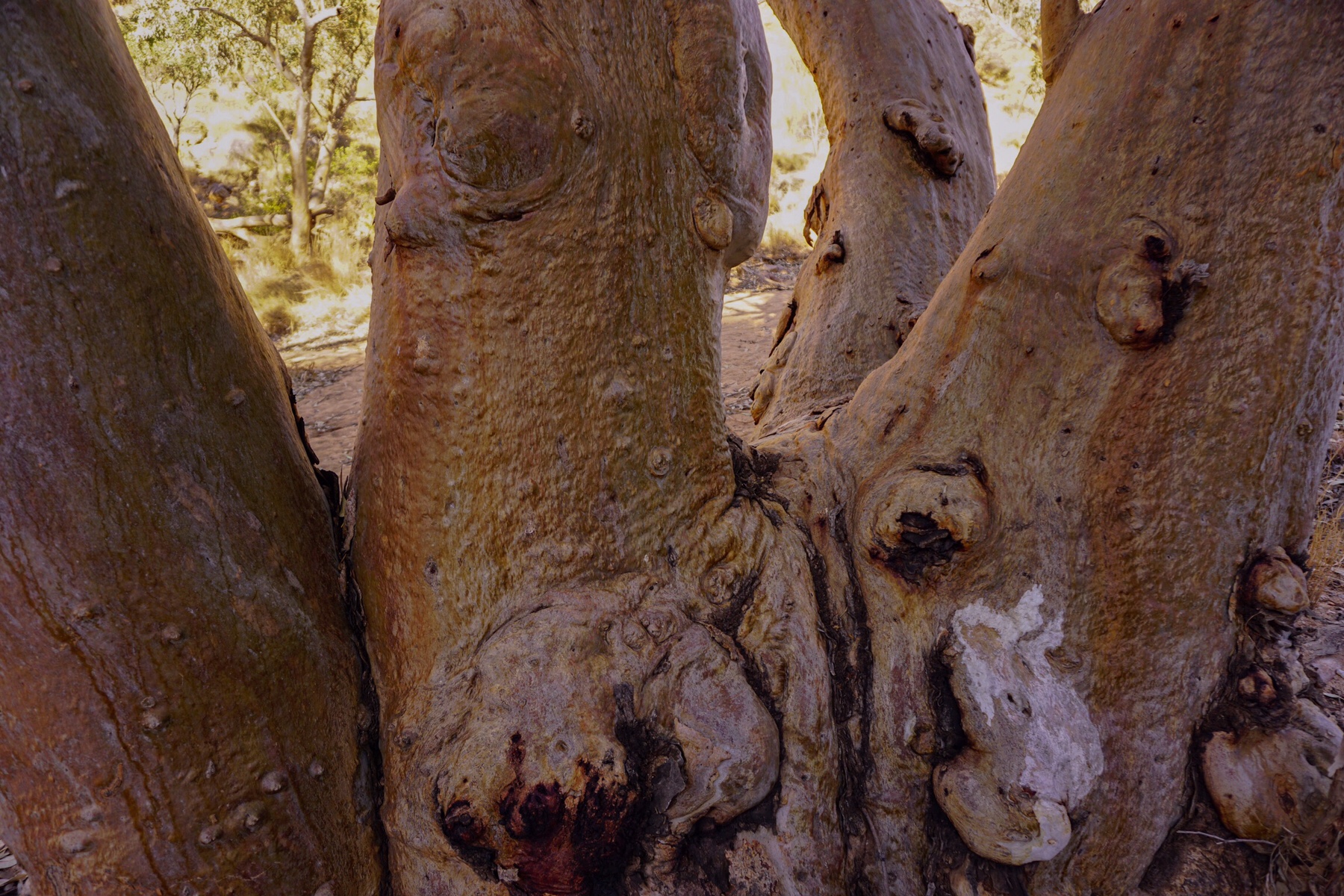
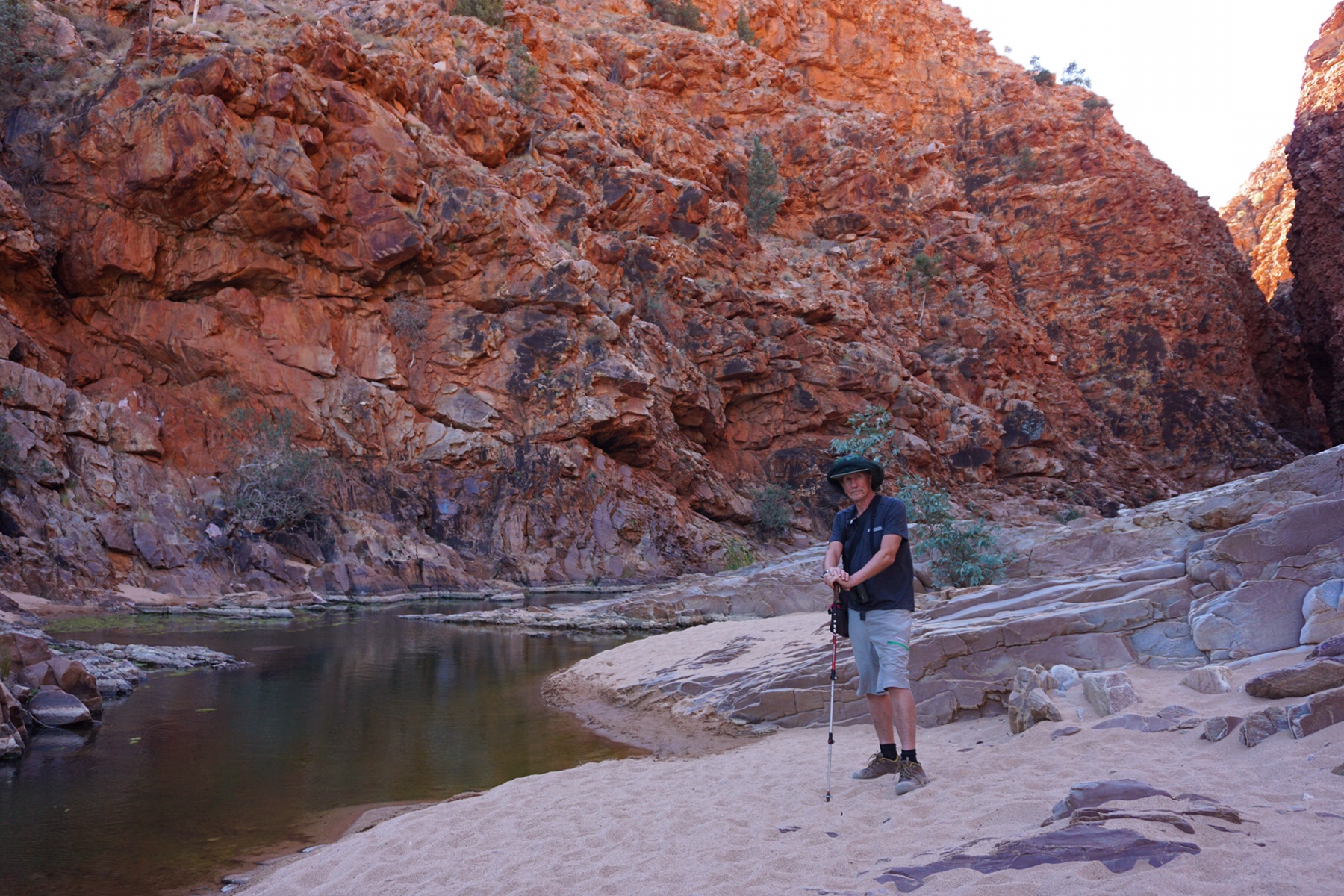 After a bit of rock scrambling we arrived at this little oasis, a pool of water in sharp contrast to the surrounding dry arid land. We spent a happy hour there watching the sun set fire to the walls of the gorge, then retraced our steps.
After a bit of rock scrambling we arrived at this little oasis, a pool of water in sharp contrast to the surrounding dry arid land. We spent a happy hour there watching the sun set fire to the walls of the gorge, then retraced our steps.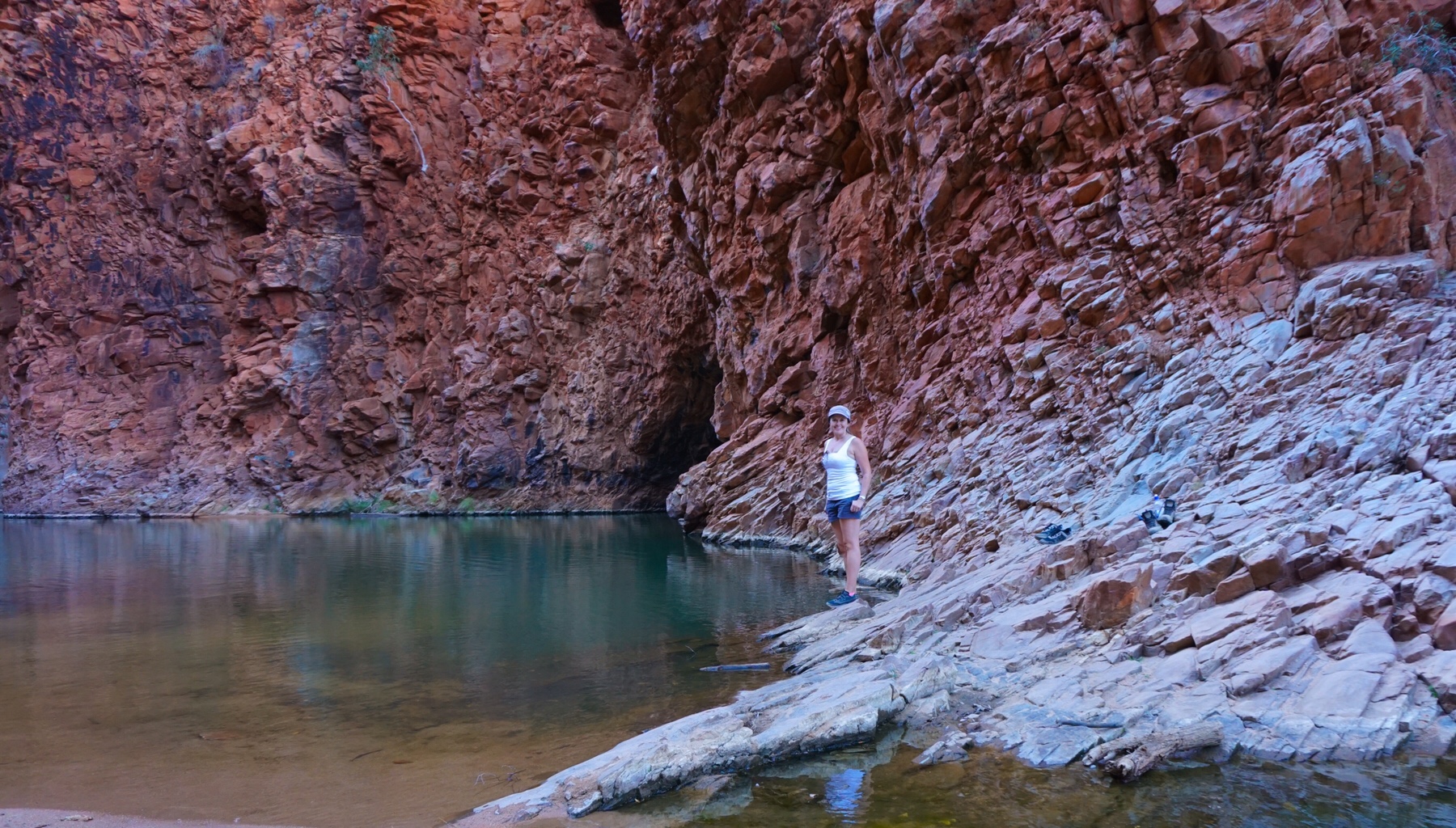
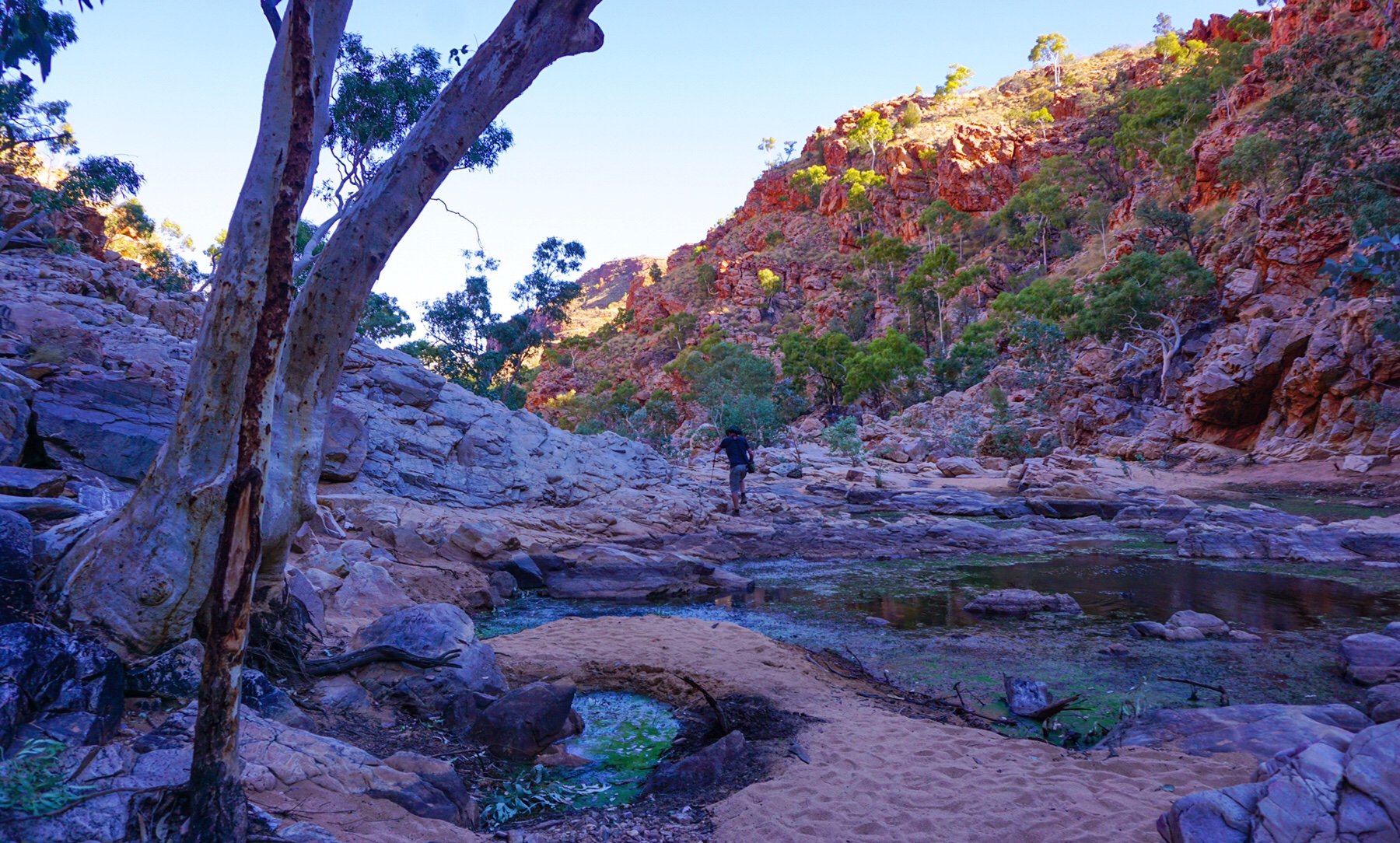
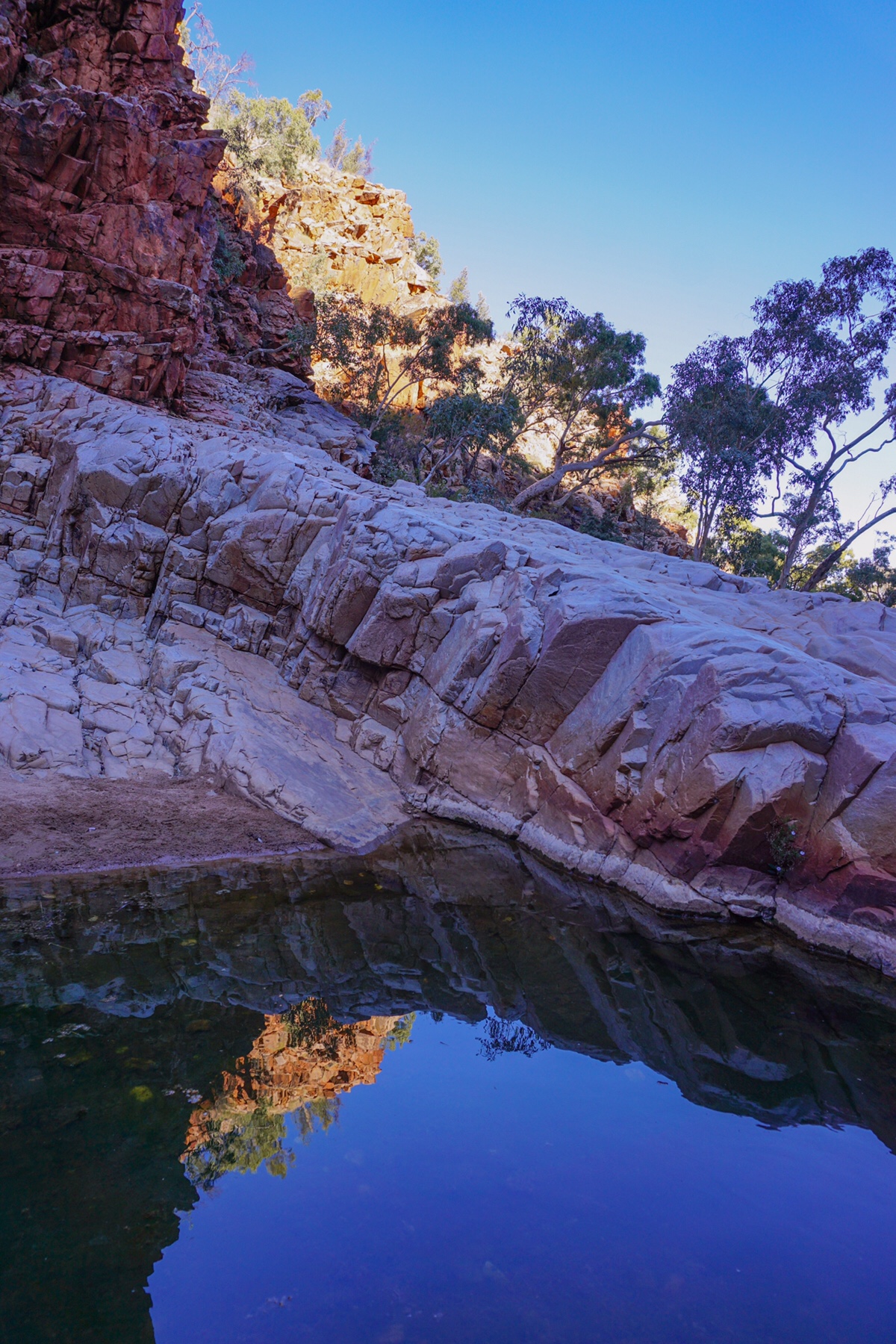 This was a view that demanded a decent glass of red, and we counted our blessings once again to be in the position to watch the sun go down on such a stunning outback vista.
This was a view that demanded a decent glass of red, and we counted our blessings once again to be in the position to watch the sun go down on such a stunning outback vista.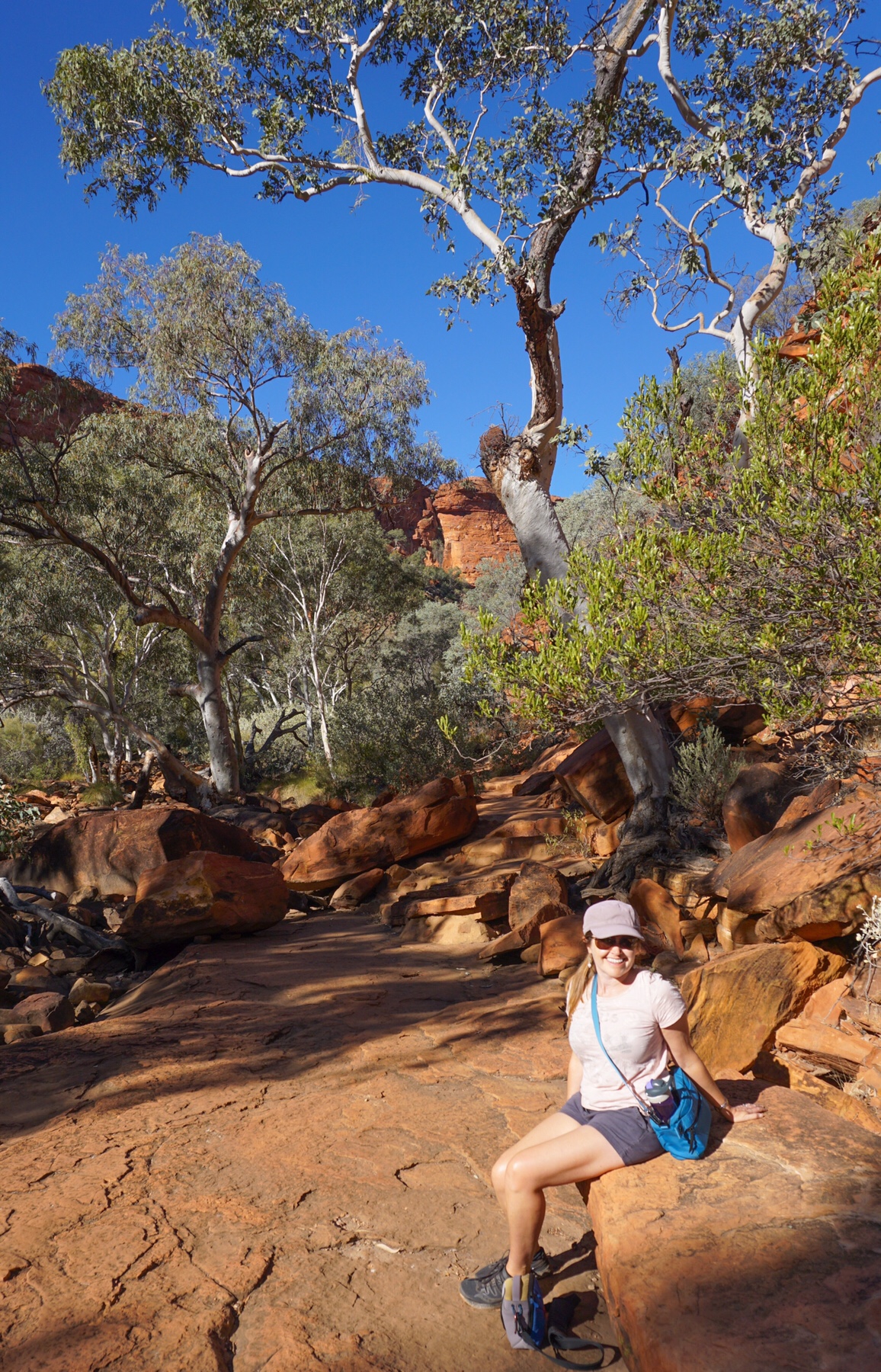
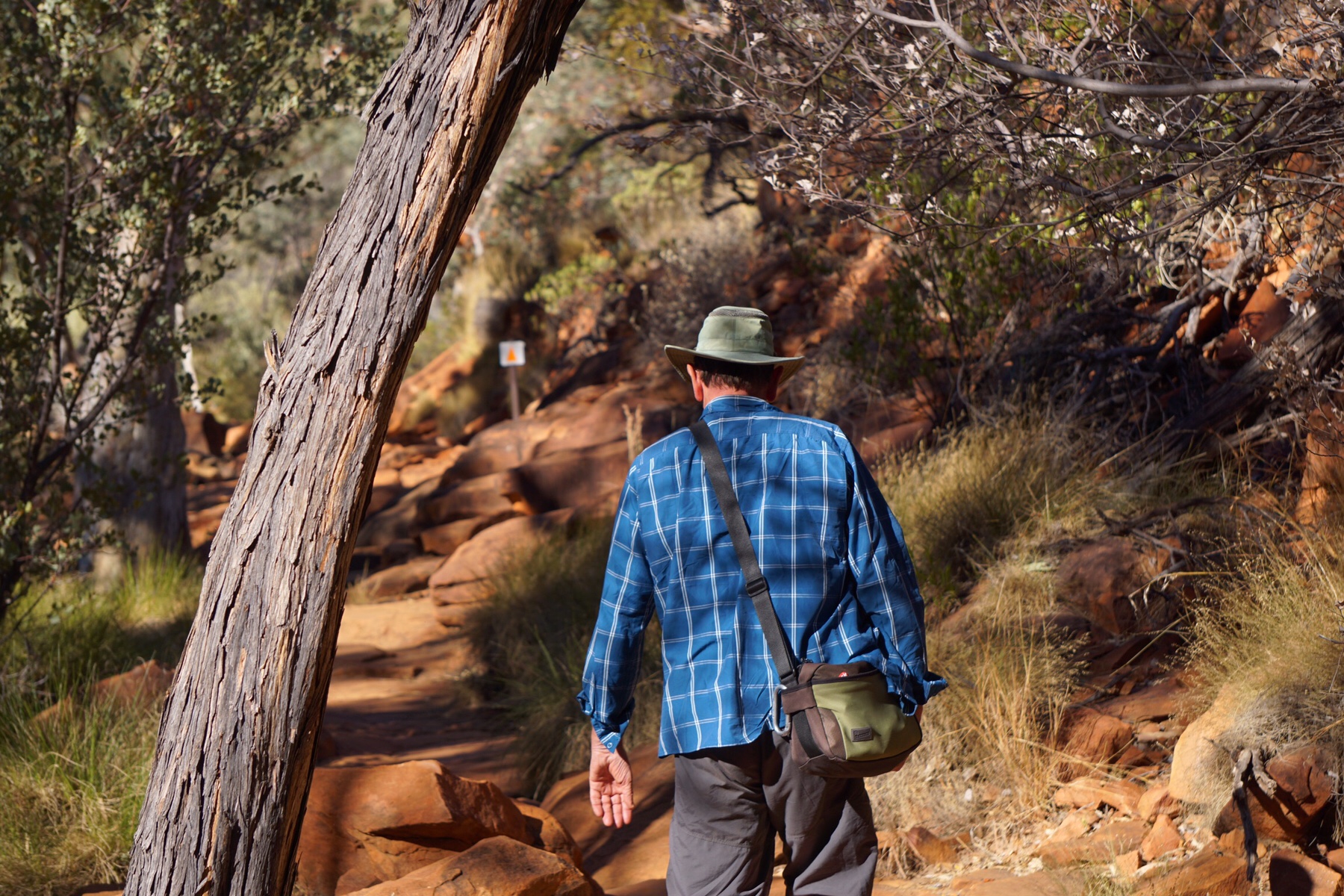
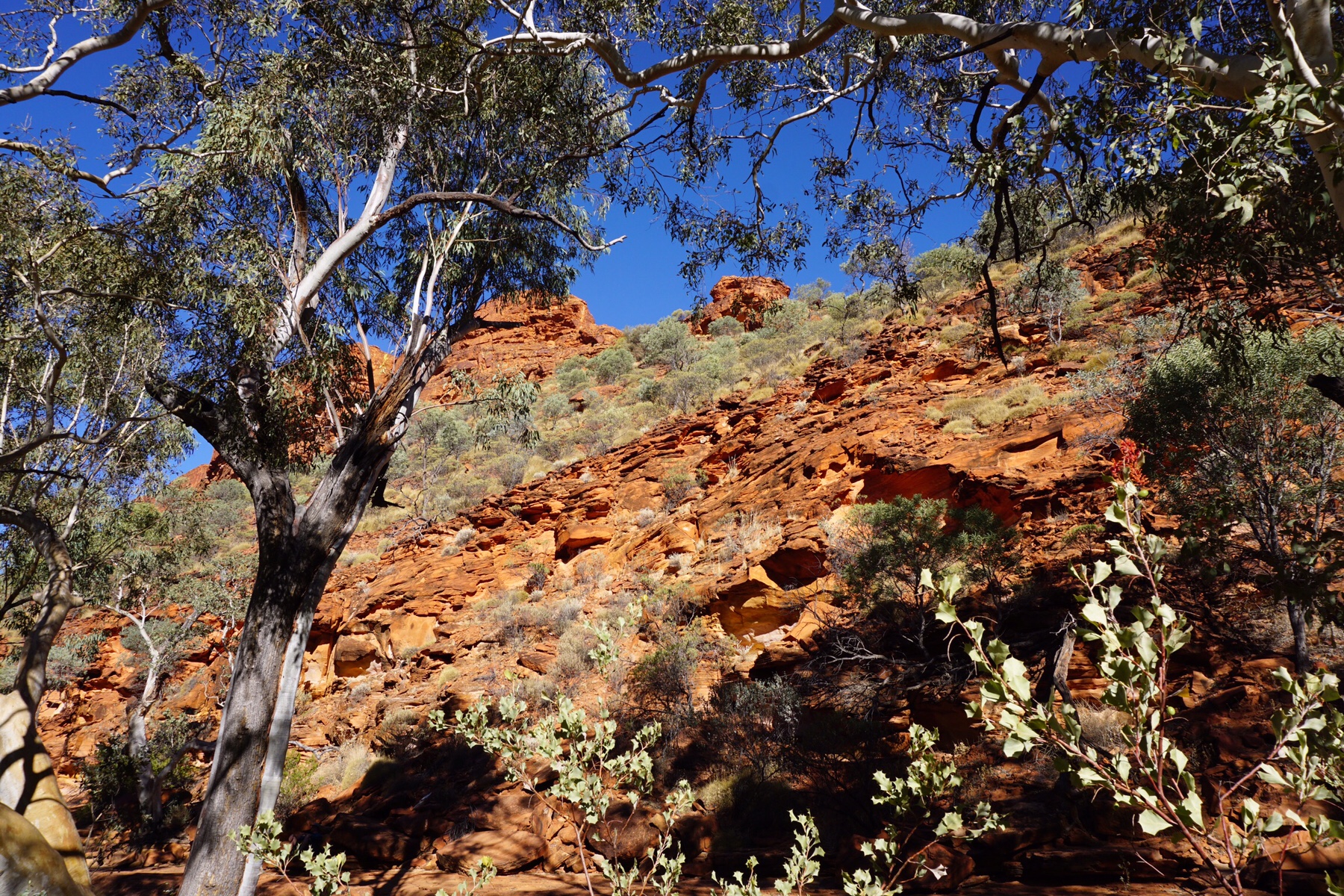 We opted for a short and peaceful walk along the dry King’s Creek, an informative track with several birds accompanying us, particularly this ever-so-cute Dusky Grasswren a perky little desert dweller that didn’t seem to mind hopping around the rocks near us.
We opted for a short and peaceful walk along the dry King’s Creek, an informative track with several birds accompanying us, particularly this ever-so-cute Dusky Grasswren a perky little desert dweller that didn’t seem to mind hopping around the rocks near us.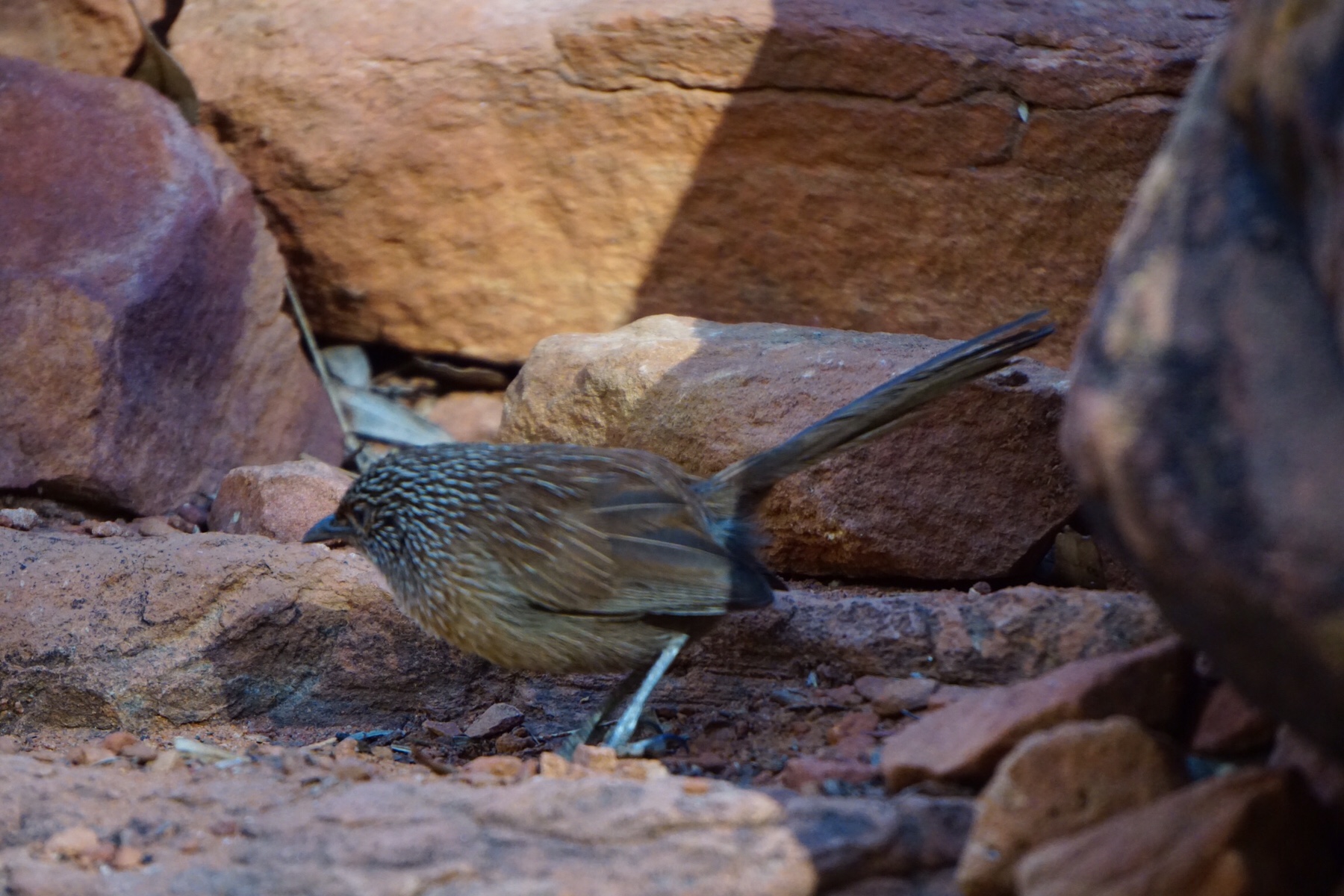 The national park is home to more than 600 species of plant, 10% of which are extremely rare and date back to the dinosaurs. This area has the highest diversity of fauna in any of Australia’s arid zones.
The national park is home to more than 600 species of plant, 10% of which are extremely rare and date back to the dinosaurs. This area has the highest diversity of fauna in any of Australia’s arid zones. The resort has a pub and restaurant so we decided to give it a try for dinner. Unlike so many places we have come across on this trip, this actually had a decent choice of beverages – including Fat Yak and our local Manly, Sydney tipple, Four Pines beer.
The resort has a pub and restaurant so we decided to give it a try for dinner. Unlike so many places we have come across on this trip, this actually had a decent choice of beverages – including Fat Yak and our local Manly, Sydney tipple, Four Pines beer.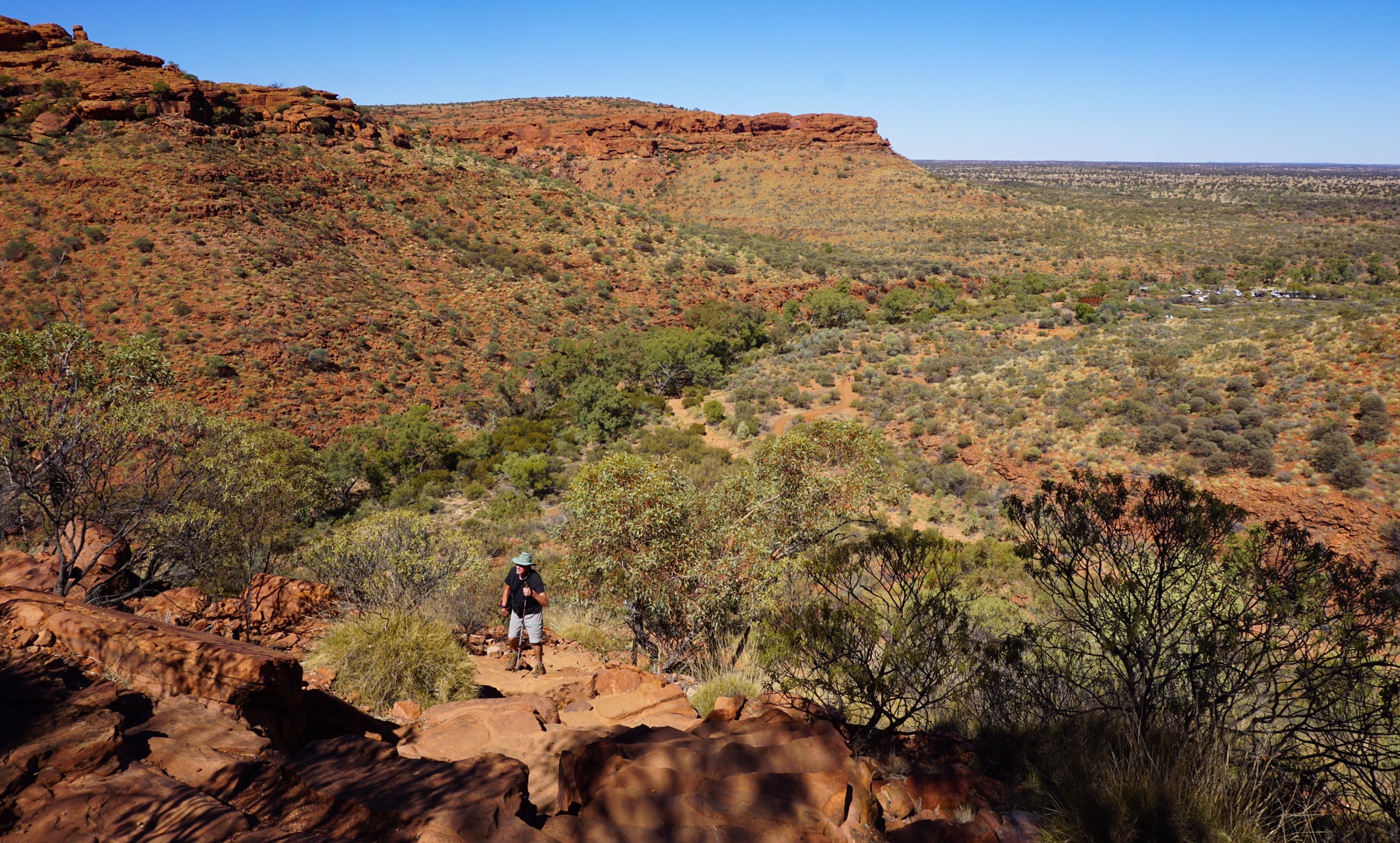 Once you’re up the top of the walls it all gets a lot friendlier, with a lot of red rock hopping over the ancient fossilised sand dunes and sea bed. There is plenty of evidence of the area’s distant past, with fossilised ripples in the rock (they call it ripple-rock, of course) and evidence of the layers of silica in the rock from the drifting sand dunes.
Once you’re up the top of the walls it all gets a lot friendlier, with a lot of red rock hopping over the ancient fossilised sand dunes and sea bed. There is plenty of evidence of the area’s distant past, with fossilised ripples in the rock (they call it ripple-rock, of course) and evidence of the layers of silica in the rock from the drifting sand dunes.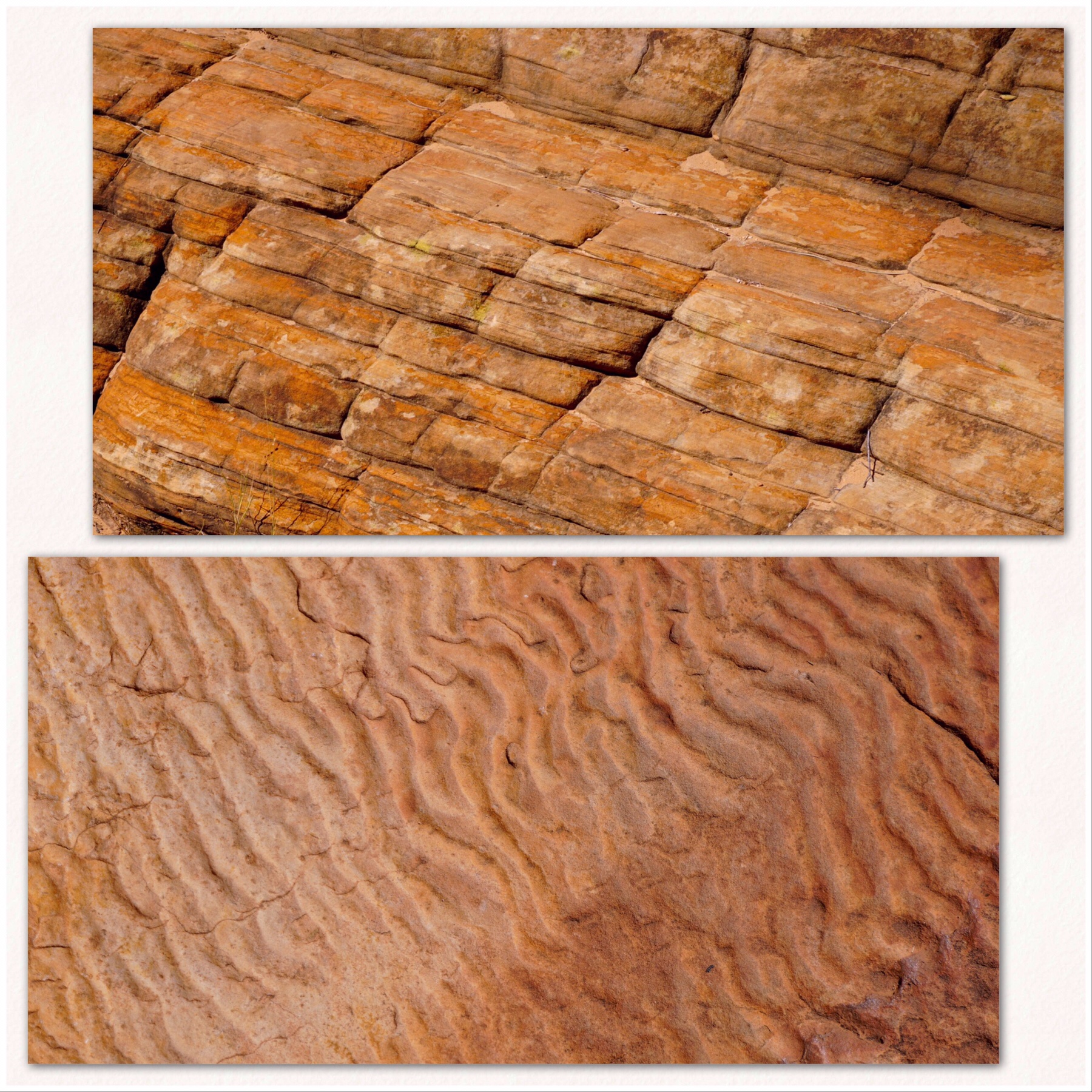 The landscape is unlike anything else, the beehive like structures stretching out into the horizon. I found it interesting to learn that the rock here is all actually bright white sandstone – the red comes from a fungi which grows on the rock and through a chemical reaction allows the red sands from the surrounding arid area to stick to it, hence creating the bright red colour which practically glows in the sunlight.
The landscape is unlike anything else, the beehive like structures stretching out into the horizon. I found it interesting to learn that the rock here is all actually bright white sandstone – the red comes from a fungi which grows on the rock and through a chemical reaction allows the red sands from the surrounding arid area to stick to it, hence creating the bright red colour which practically glows in the sunlight.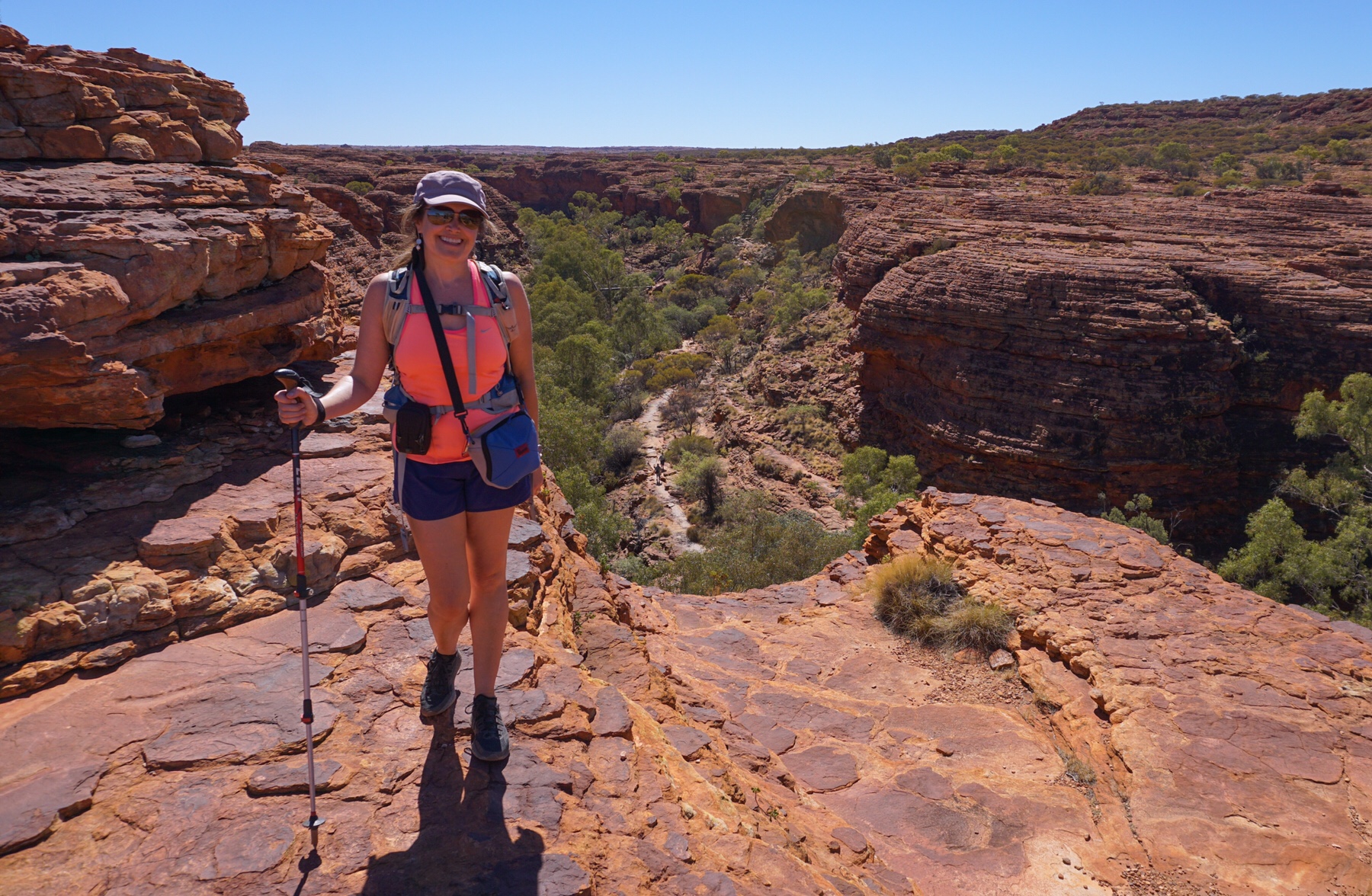
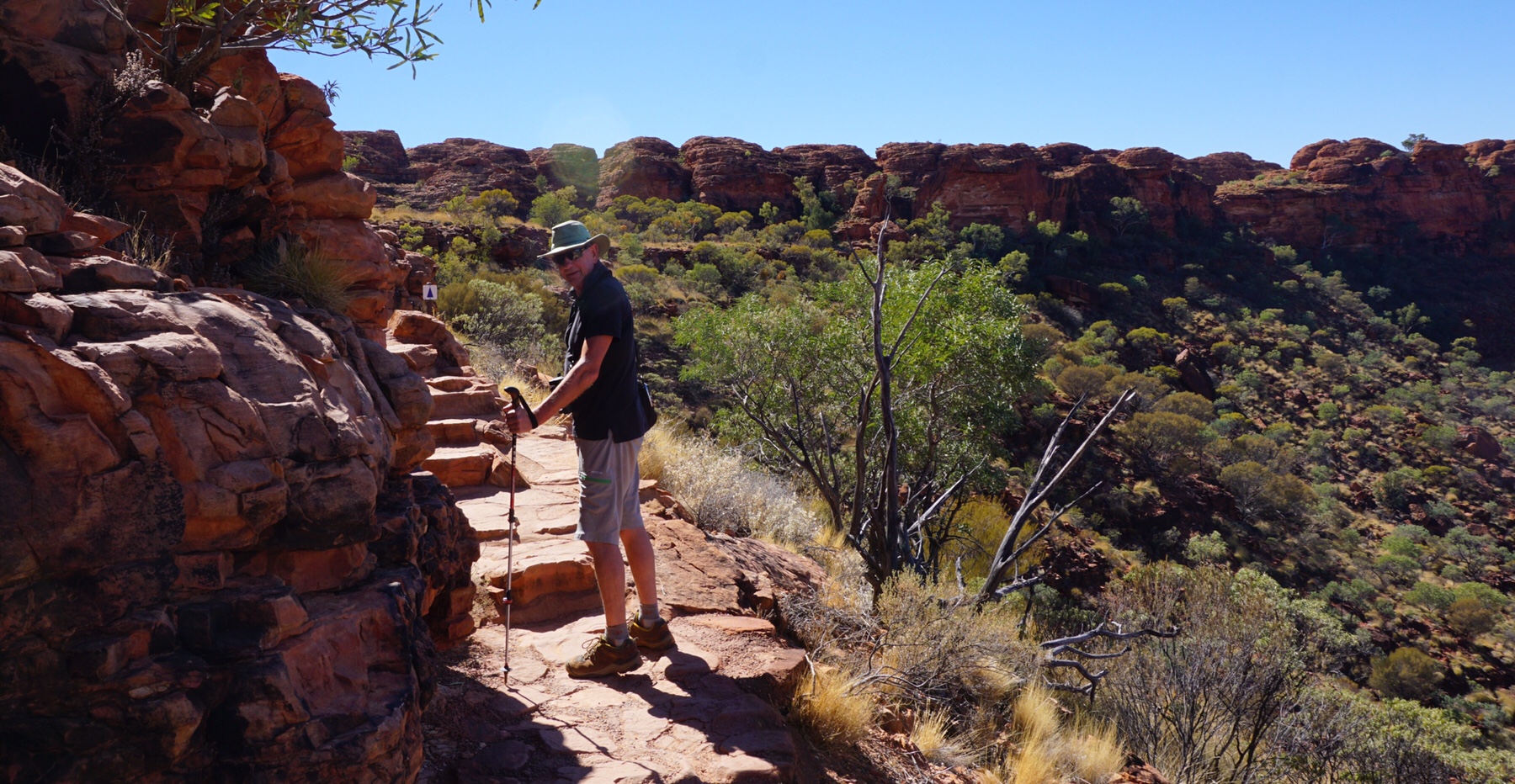
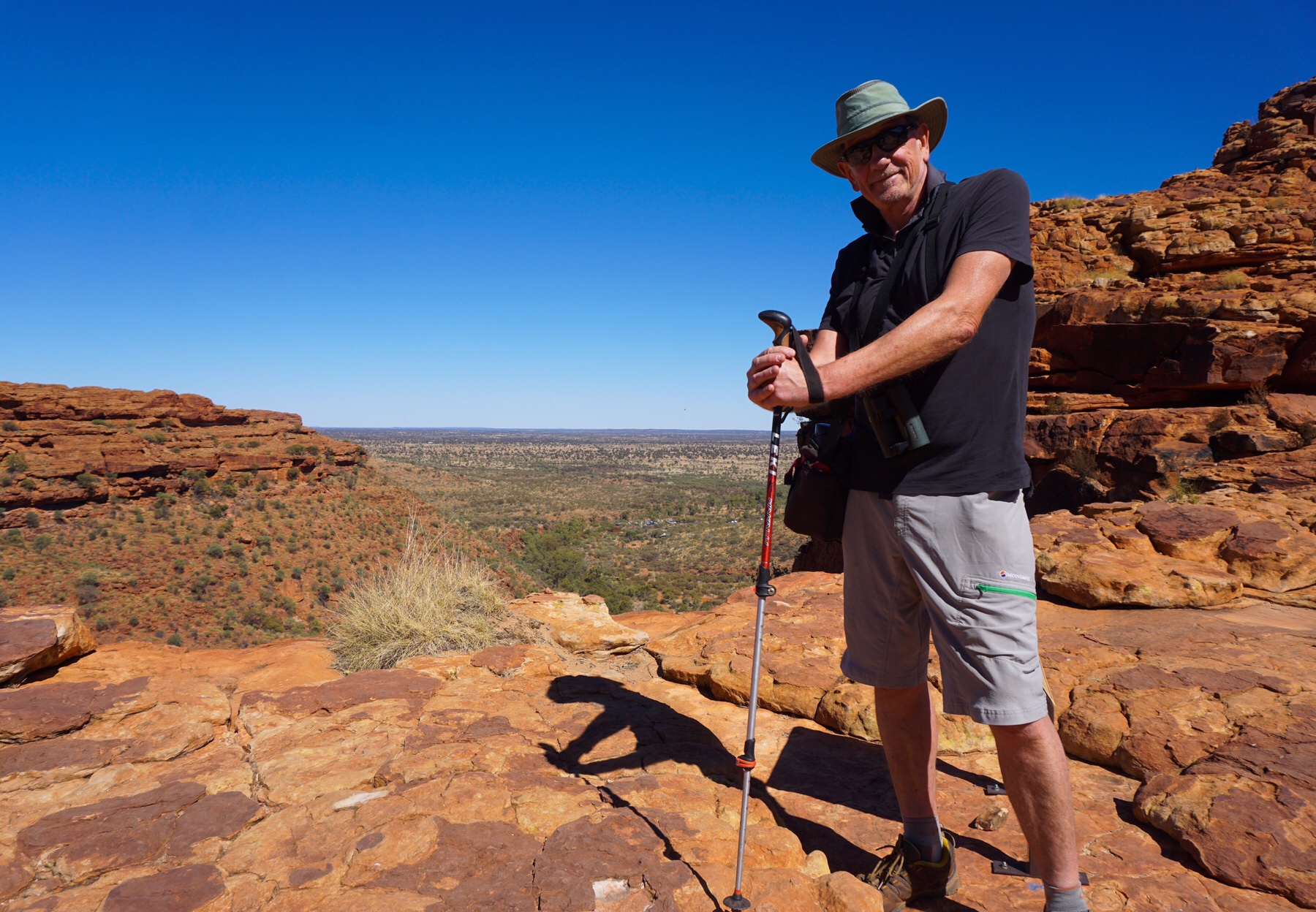
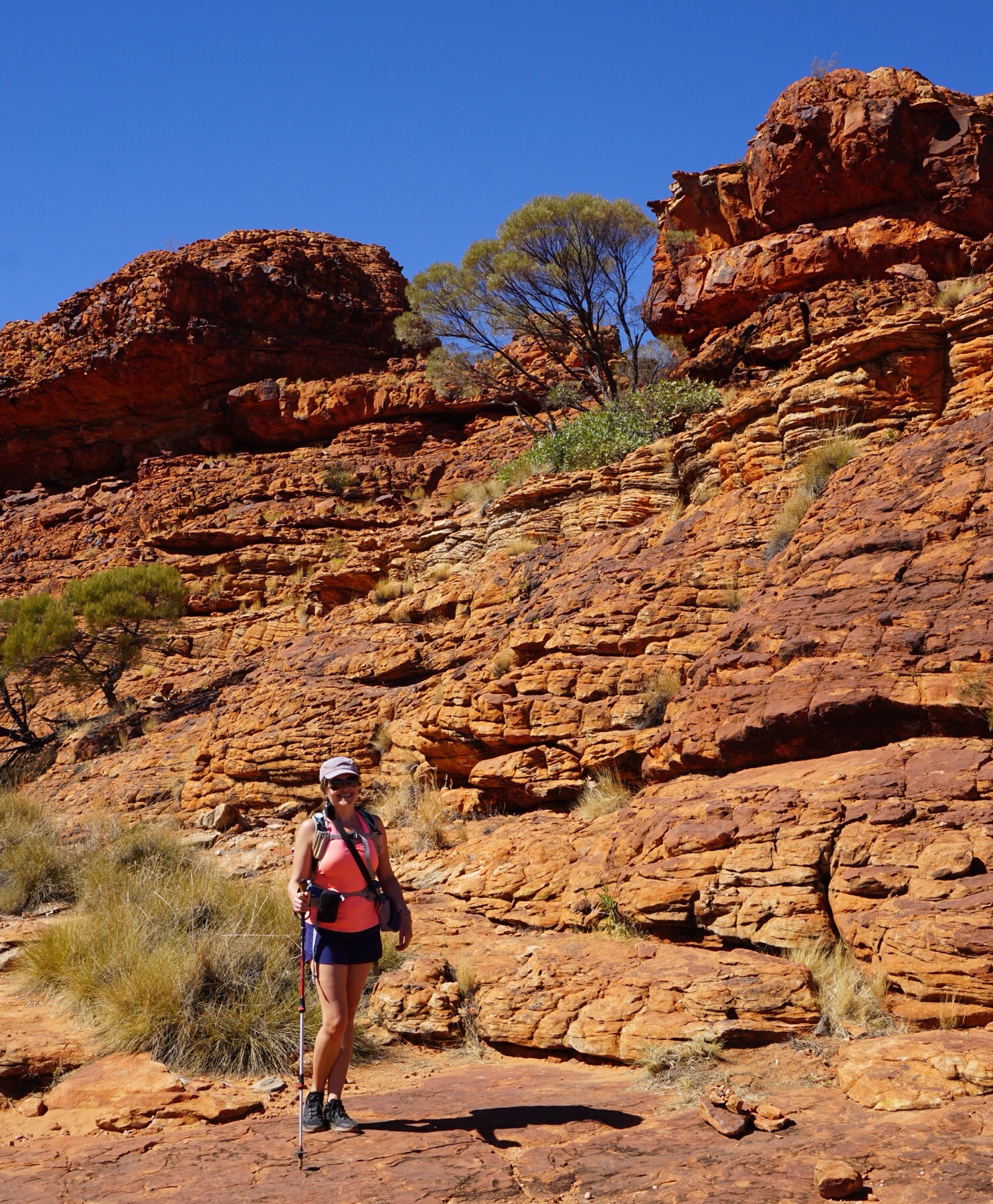 While not busy, we were certainly not alone on this walk, several other hikers following on the same trajectory – mostly French, a few Chinese and Australians.
While not busy, we were certainly not alone on this walk, several other hikers following on the same trajectory – mostly French, a few Chinese and Australians.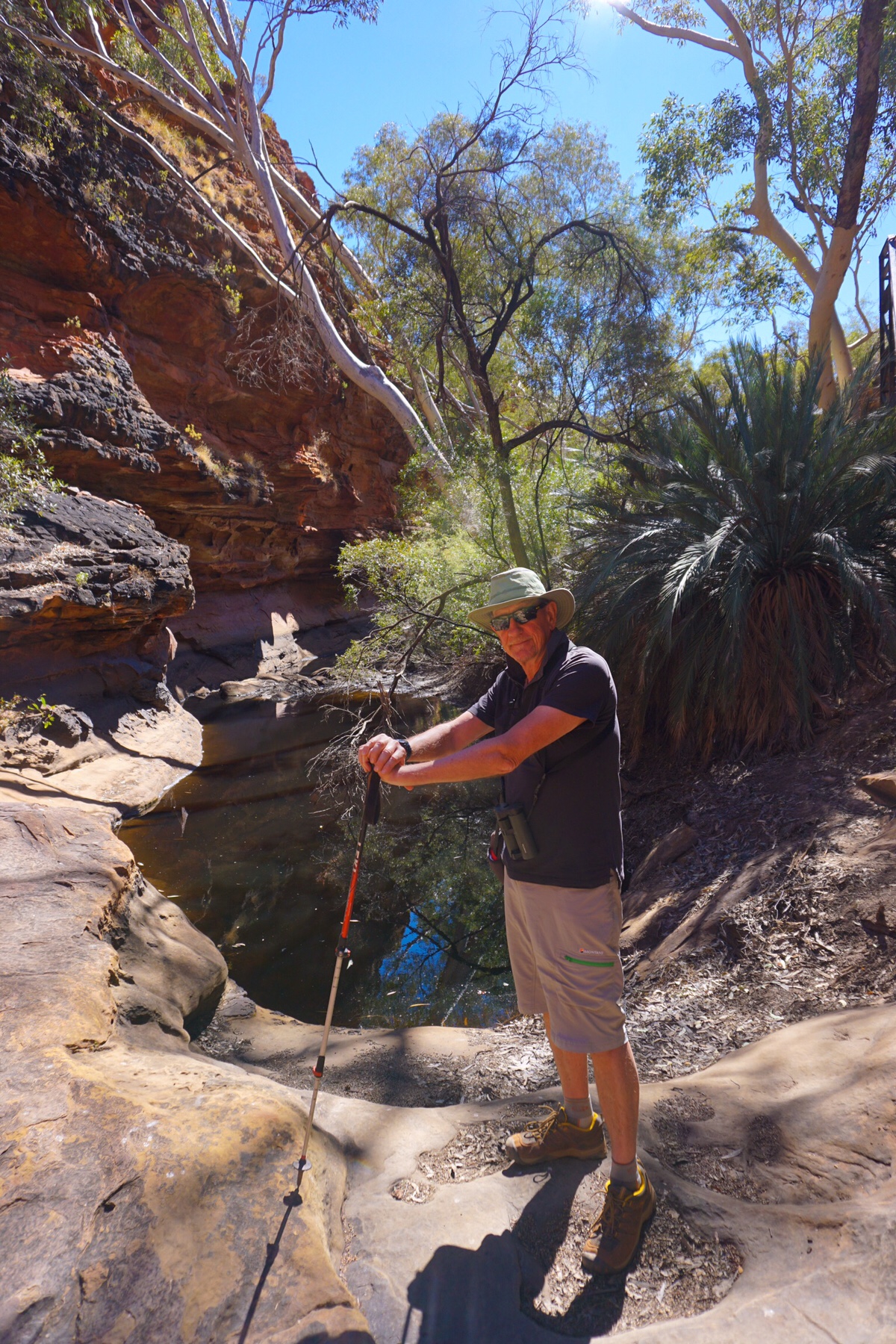
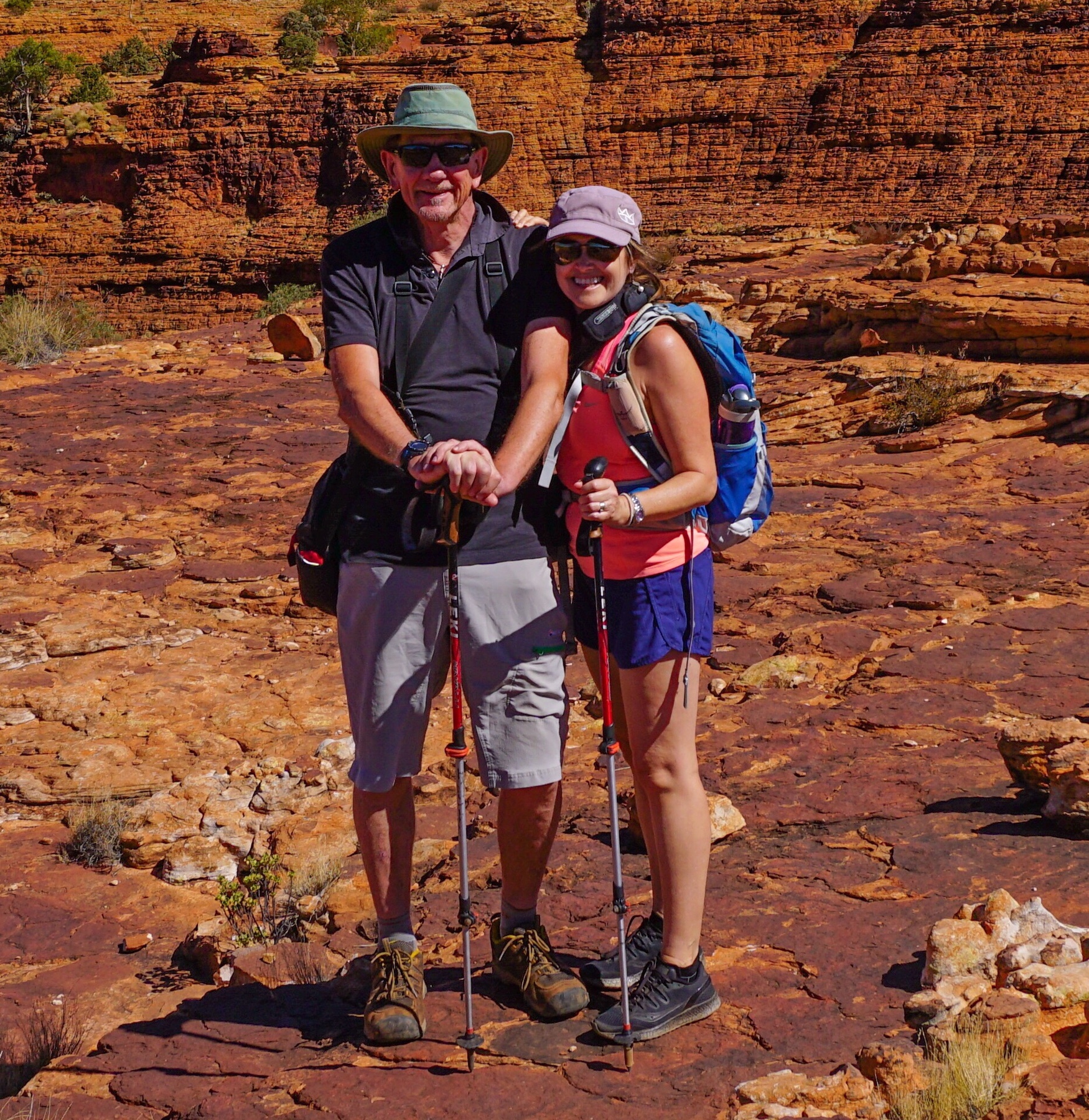
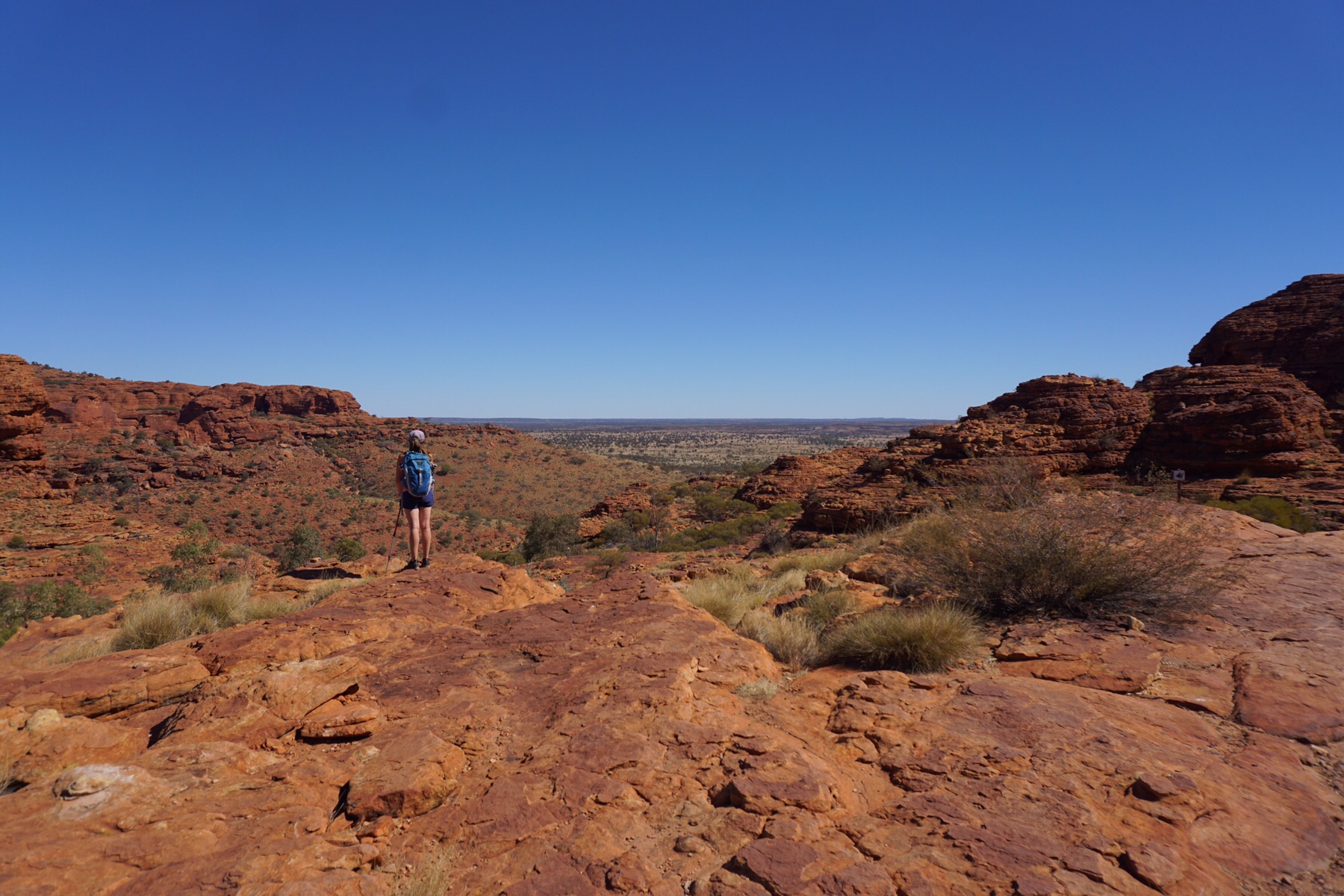 After completing the circuit we returned for a relaxed afternoon, Miss Tassie rolling in the red sand and needing a lot of brushing (which she loves!). I suspect the two events might be linked. Are we being manipulated by a Burmese cat?
After completing the circuit we returned for a relaxed afternoon, Miss Tassie rolling in the red sand and needing a lot of brushing (which she loves!). I suspect the two events might be linked. Are we being manipulated by a Burmese cat?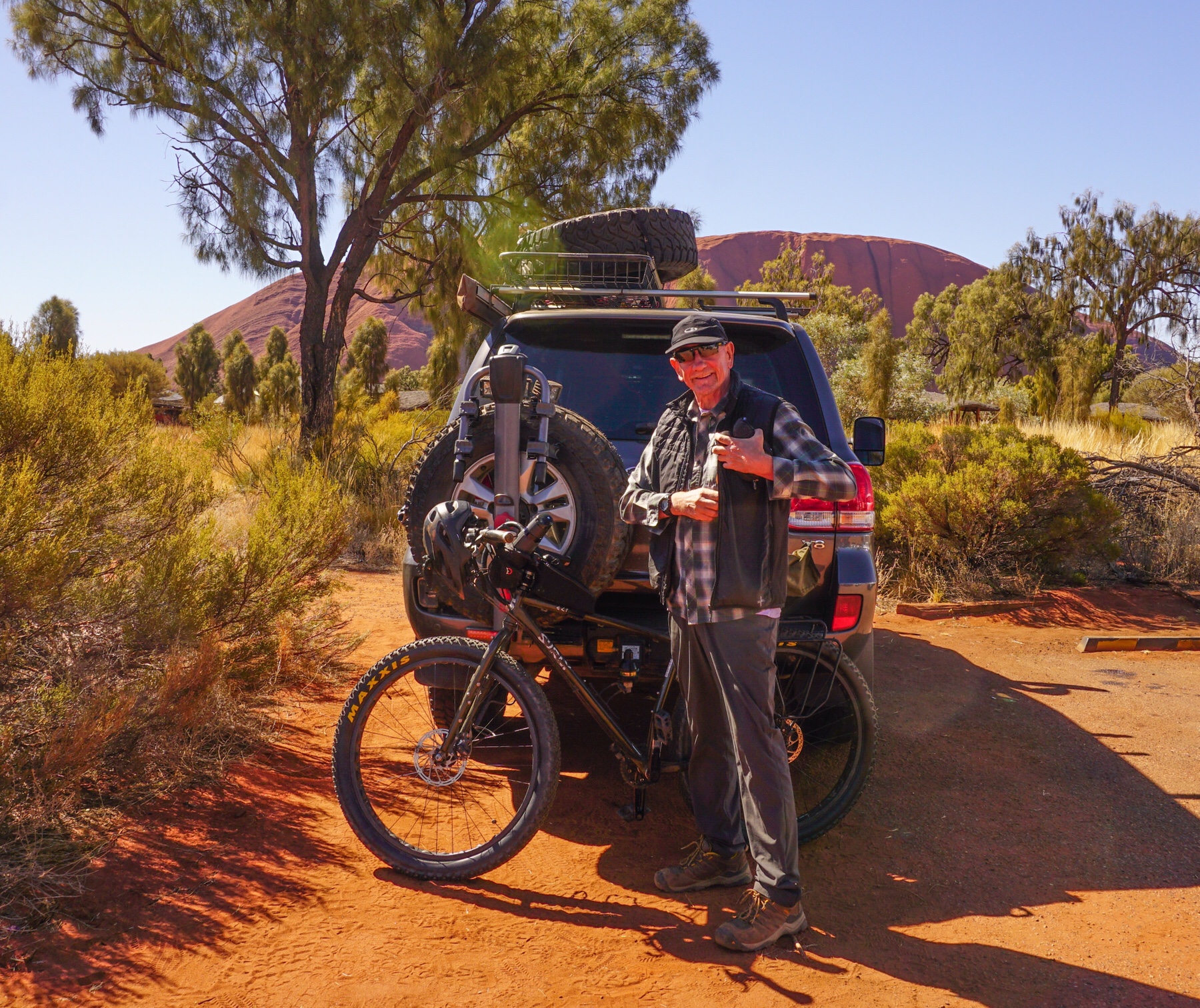 We left for our ride from the Cultural Centre and followed our noses as there were no signs for a cycling path, but there was this rather large rock to head for.
We left for our ride from the Cultural Centre and followed our noses as there were no signs for a cycling path, but there was this rather large rock to head for.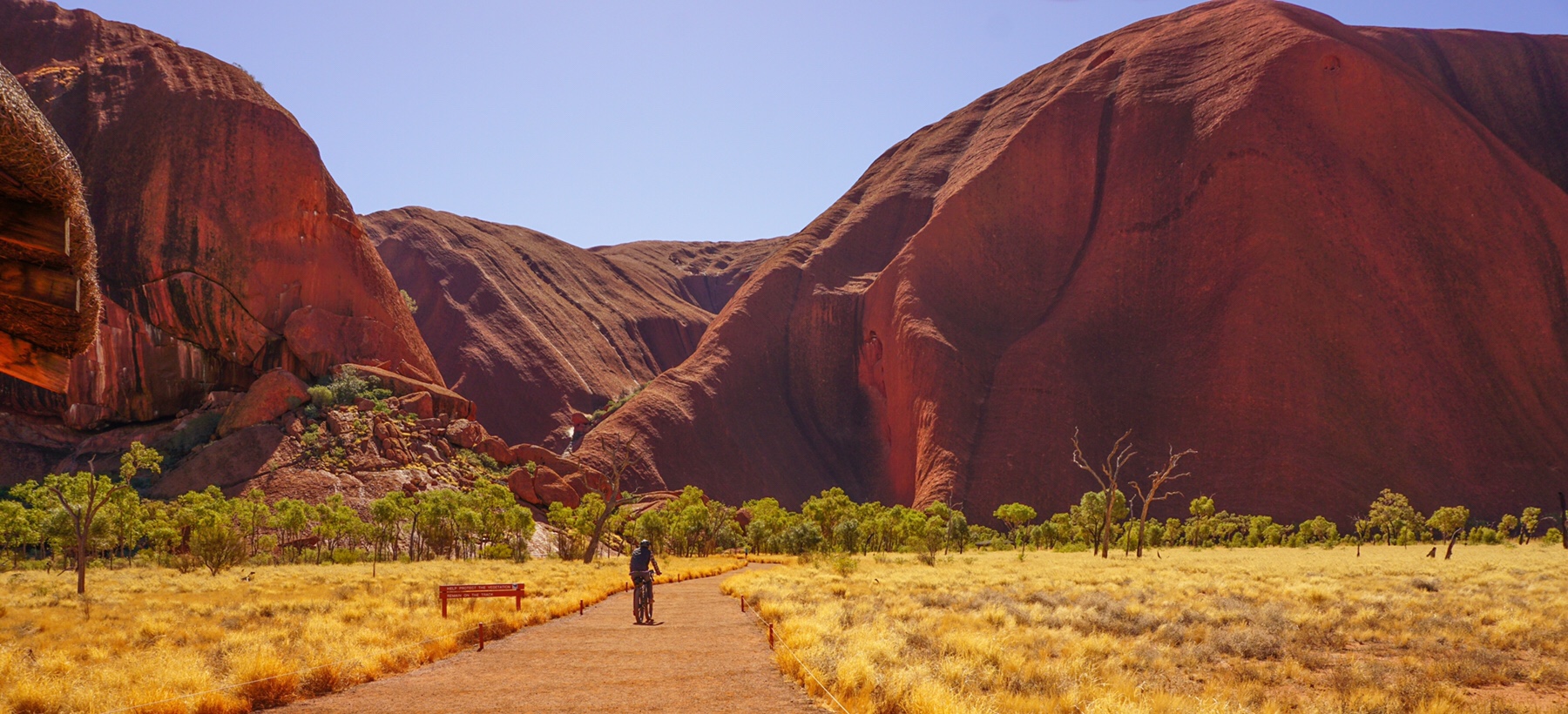
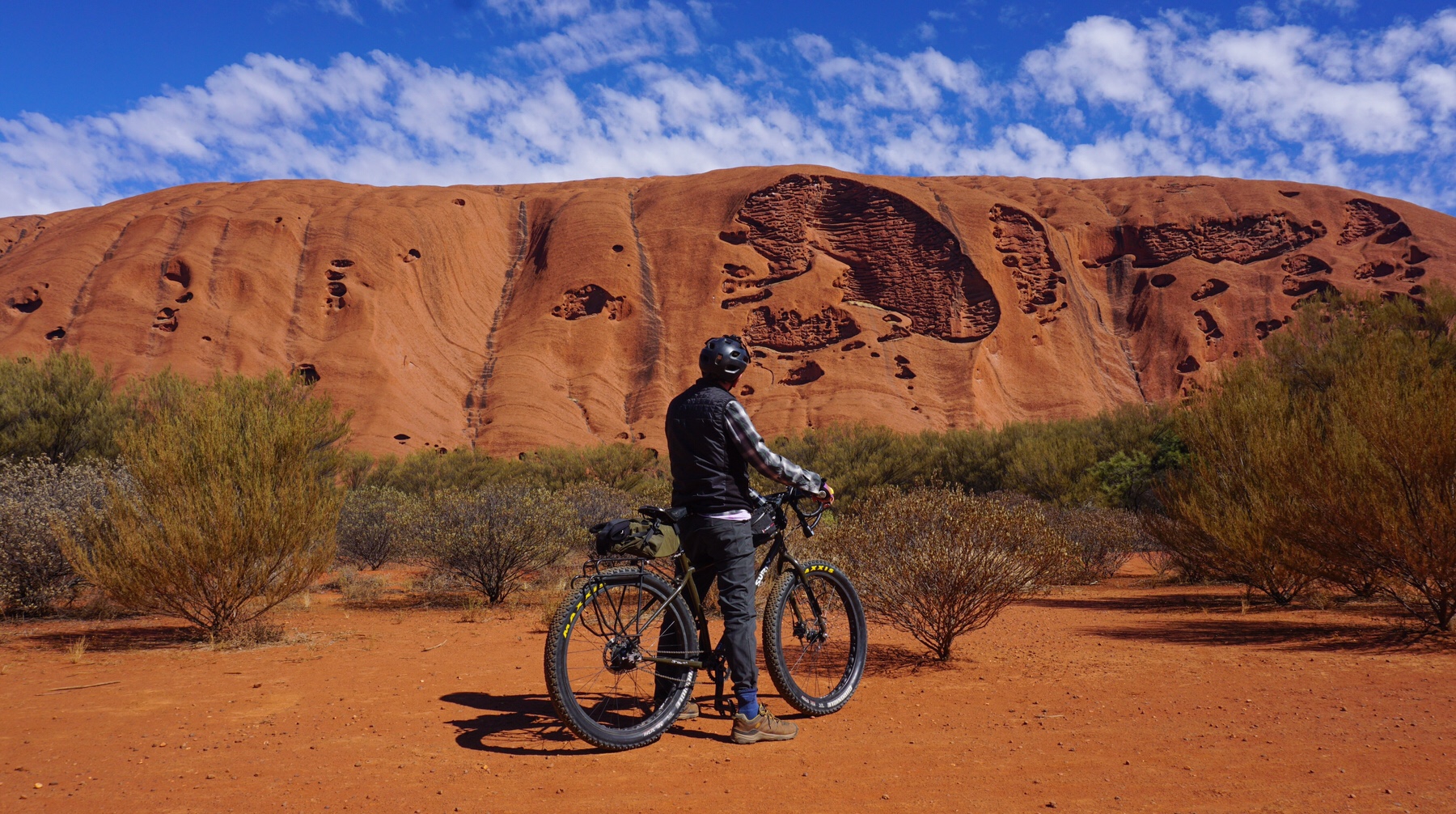
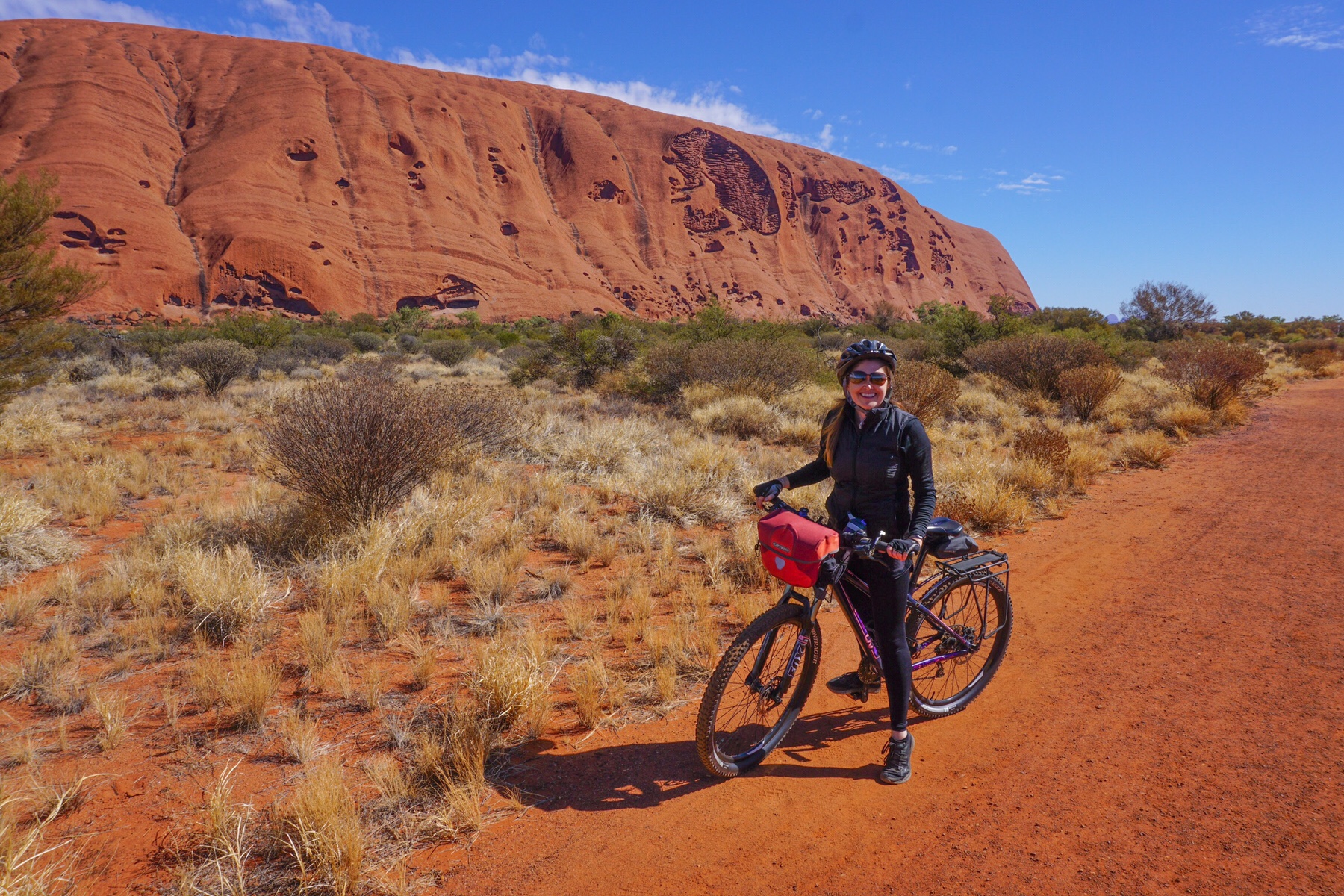 We joined the pain path around the rock and checked the signage, it only showed walkers, but there were bike hire companies around and plenty of tyre marks, so off we went.
We joined the pain path around the rock and checked the signage, it only showed walkers, but there were bike hire companies around and plenty of tyre marks, so off we went.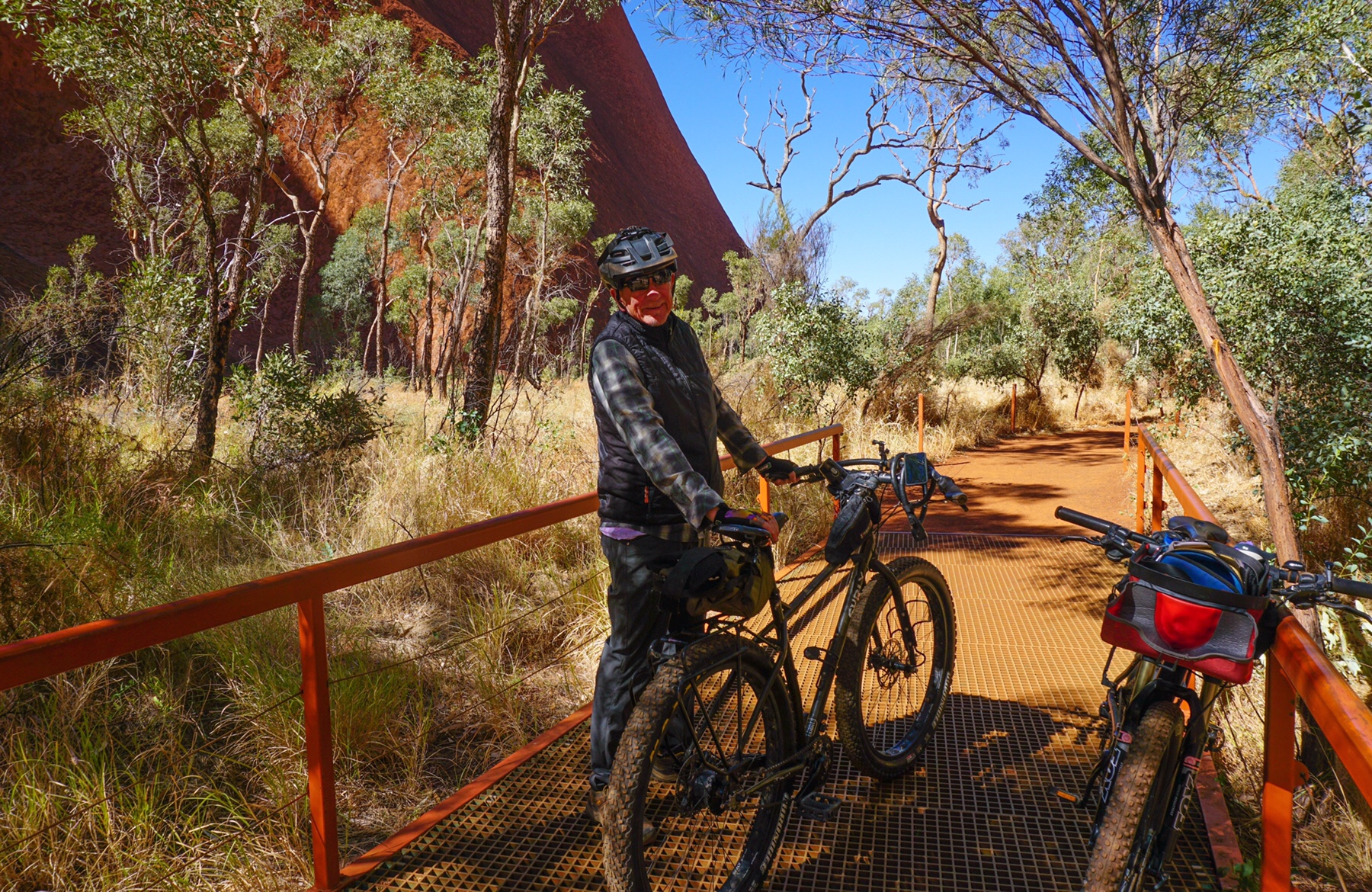
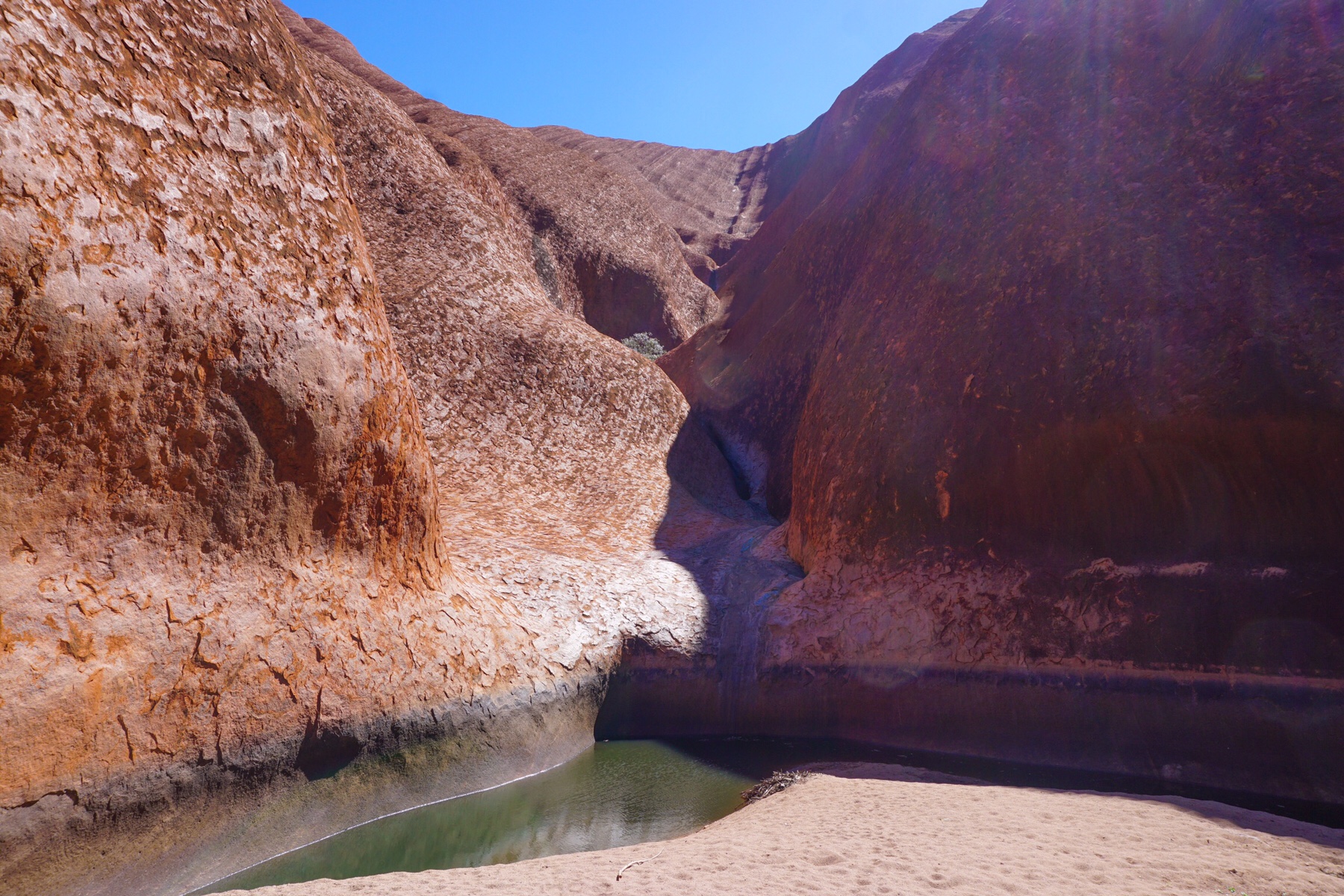
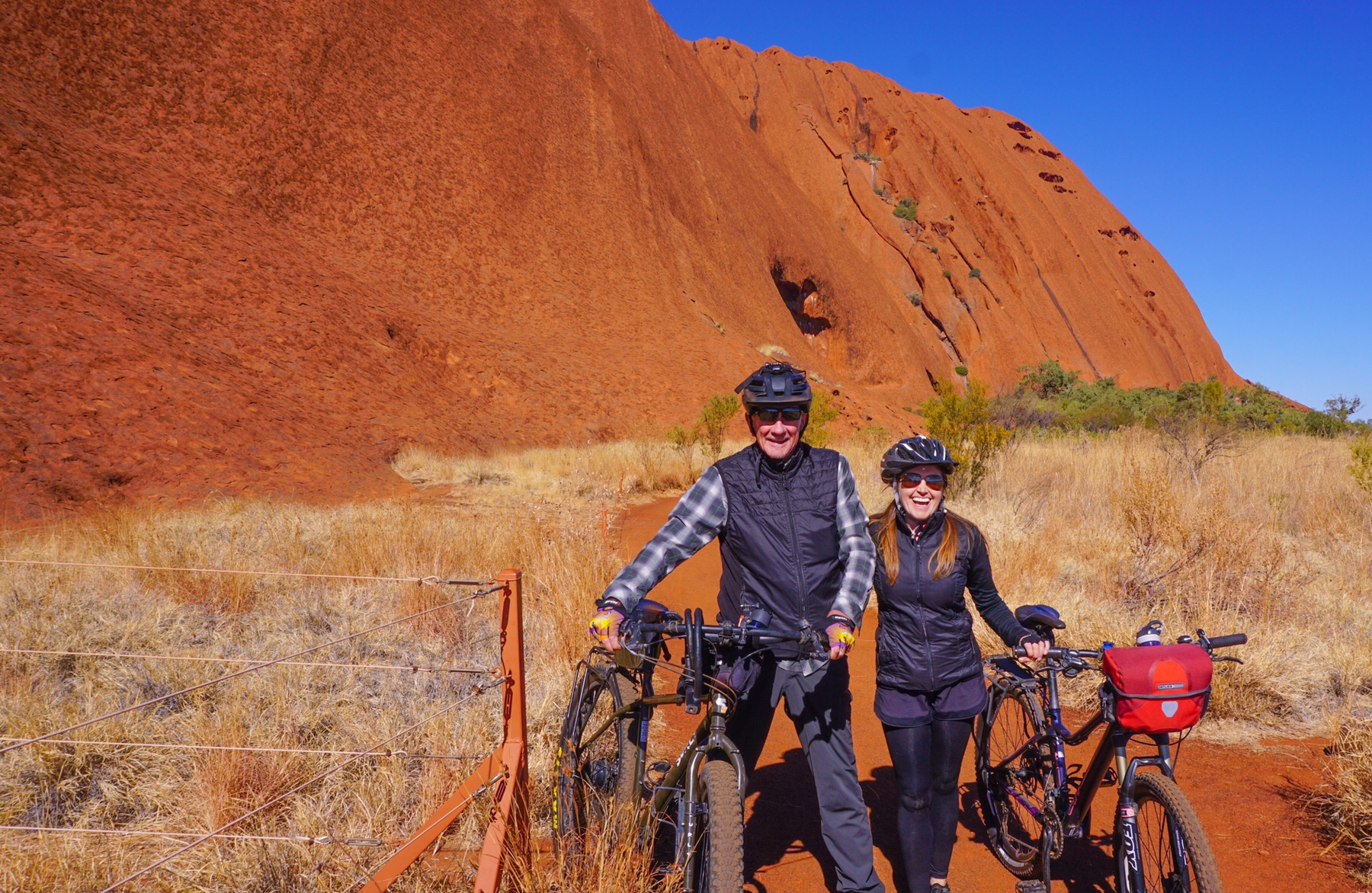 Riding a bike always brings a grin to our faces wherever we are, but to be riding along under this brilliant blue sky, dwarfed by this towering red rock…breathtaking. We just couldn’t stop ogling this magnificent scenery. Neither of us are in any way spiritual, but we both felt this to be the closest we could get, just sitting quietly looking up at this massive granite monolith towering over us.
Riding a bike always brings a grin to our faces wherever we are, but to be riding along under this brilliant blue sky, dwarfed by this towering red rock…breathtaking. We just couldn’t stop ogling this magnificent scenery. Neither of us are in any way spiritual, but we both felt this to be the closest we could get, just sitting quietly looking up at this massive granite monolith towering over us.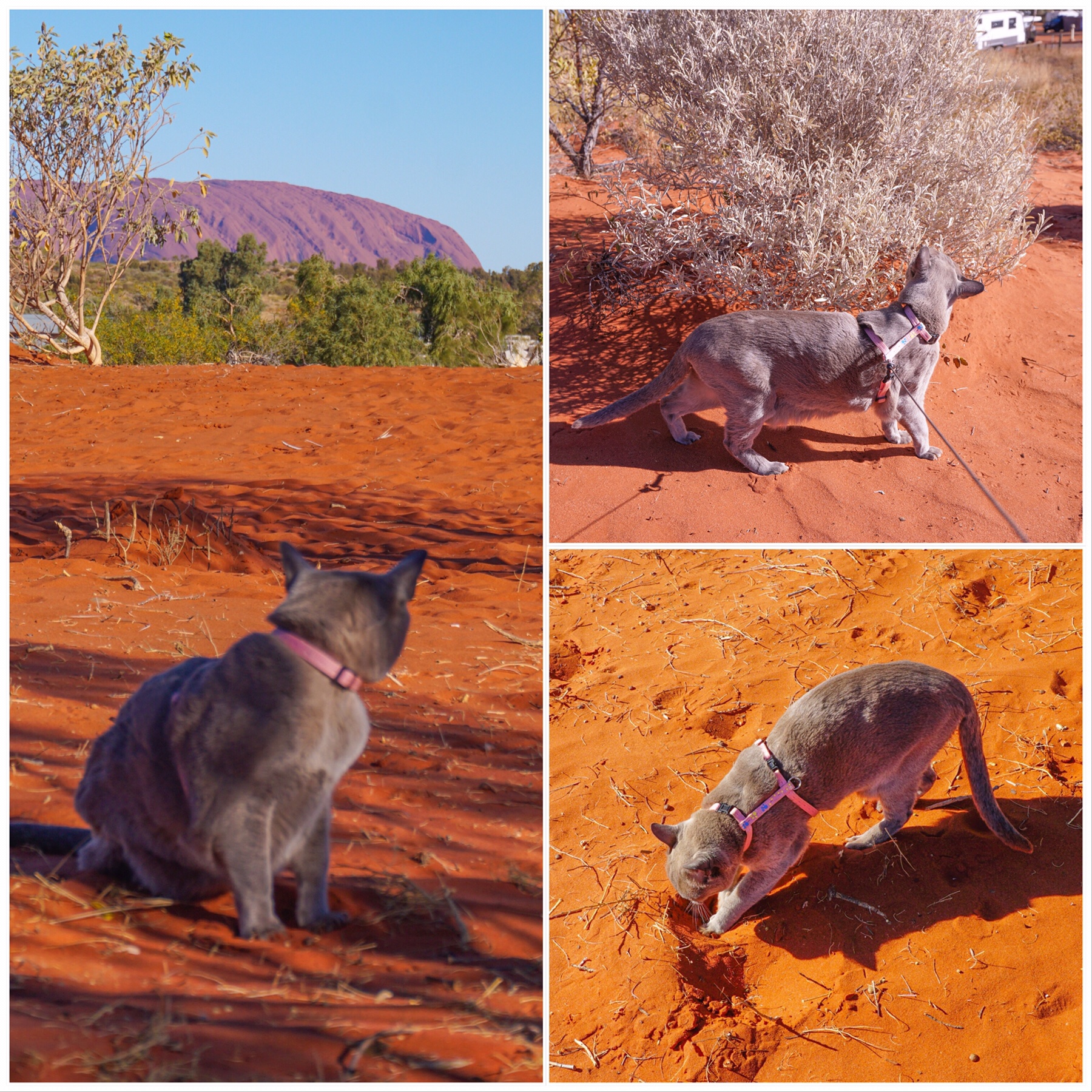
 The short walk we did here was one of the most enjoyable we have done from a scenic perspective for ages. It’s called the Valley of the Winds walk, and takes you up through the domes and in a 7km circuit.
The short walk we did here was one of the most enjoyable we have done from a scenic perspective for ages. It’s called the Valley of the Winds walk, and takes you up through the domes and in a 7km circuit.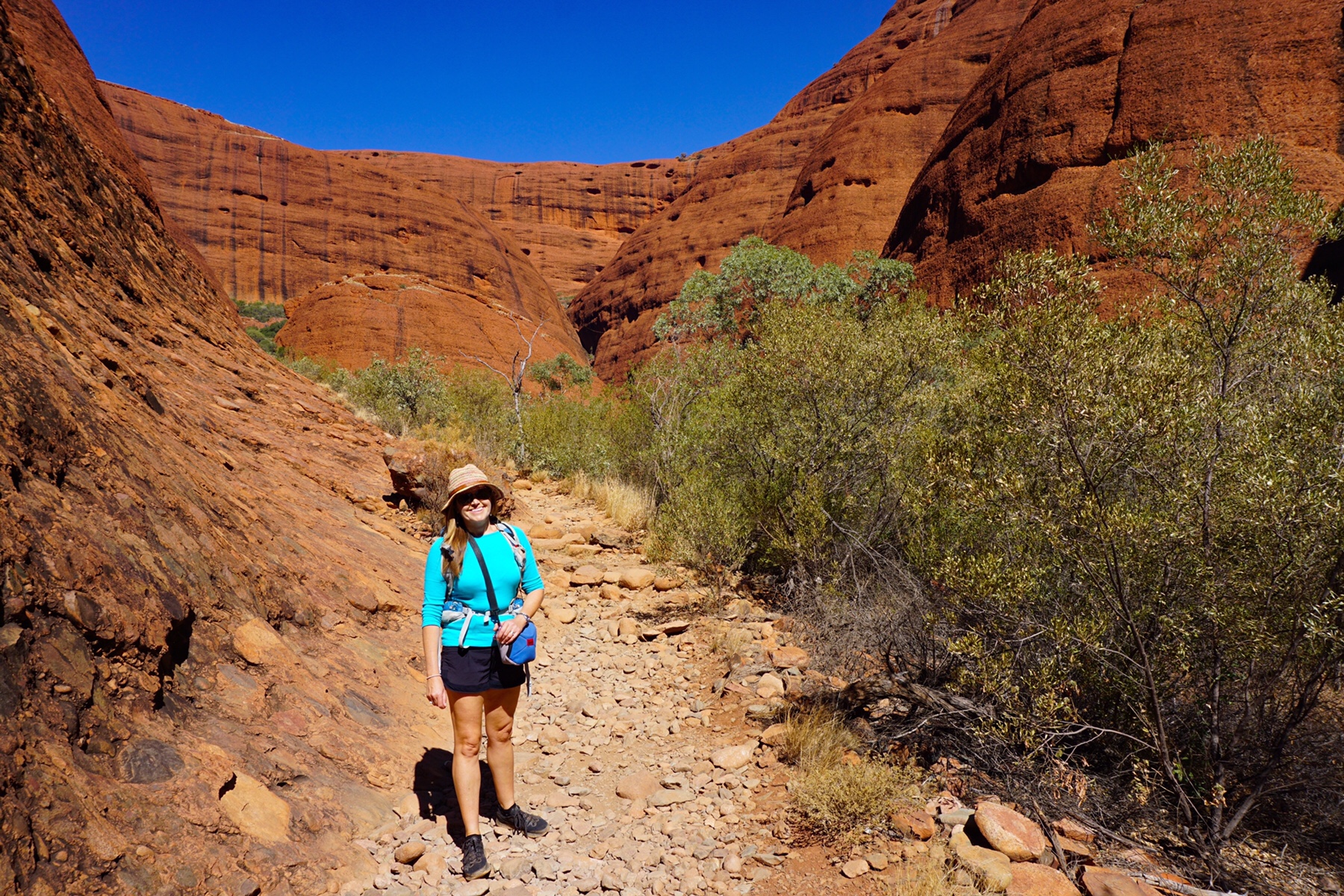
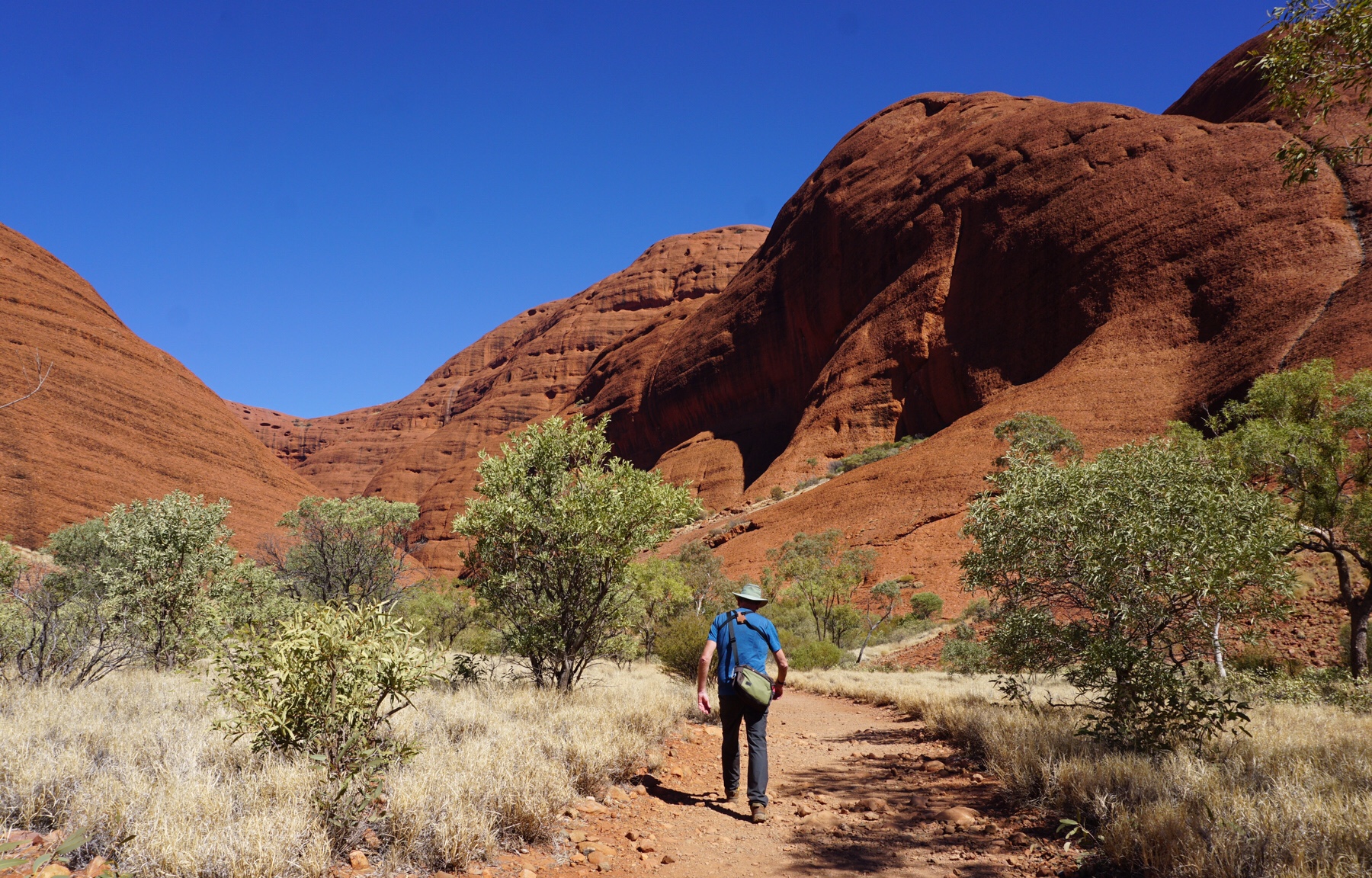
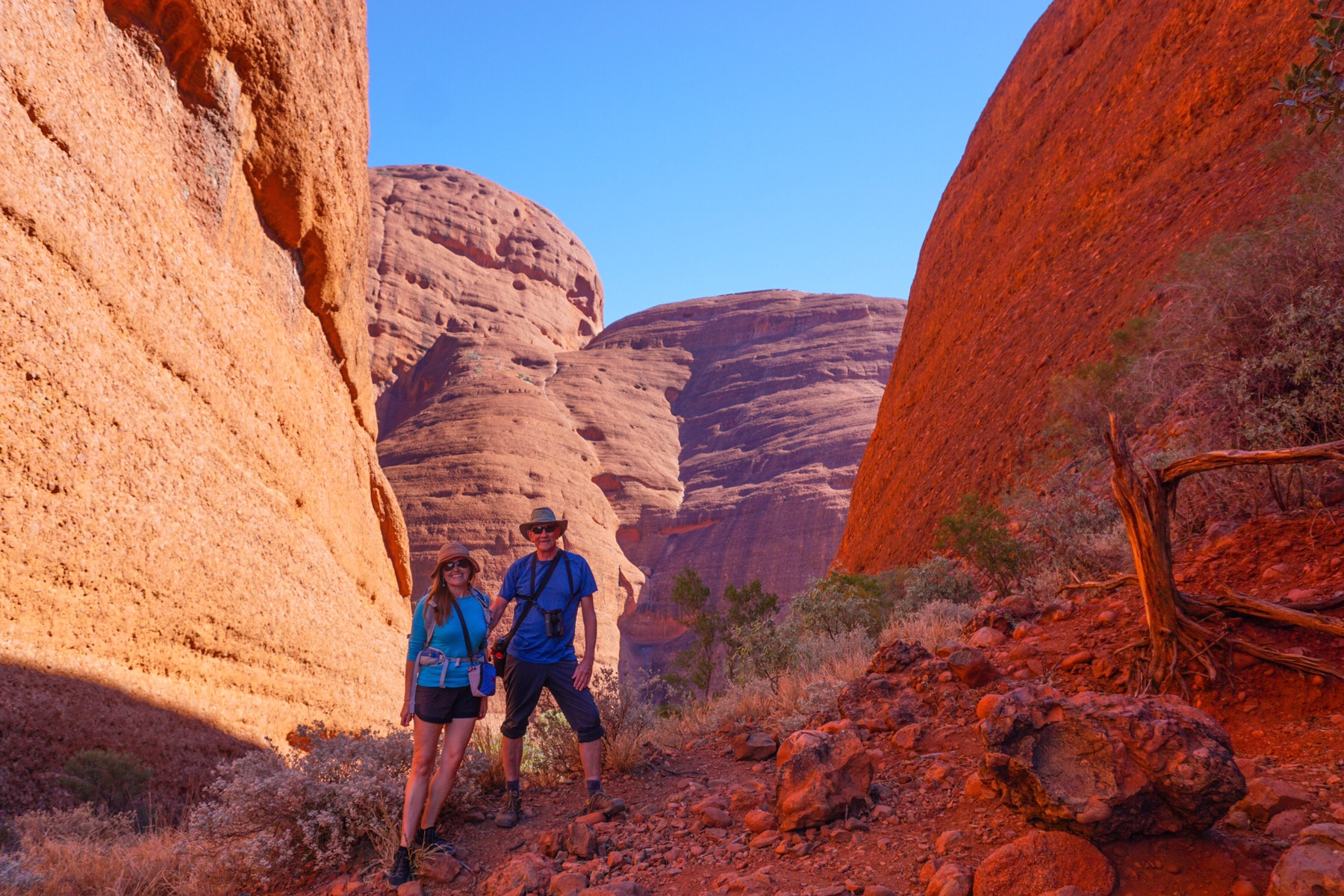
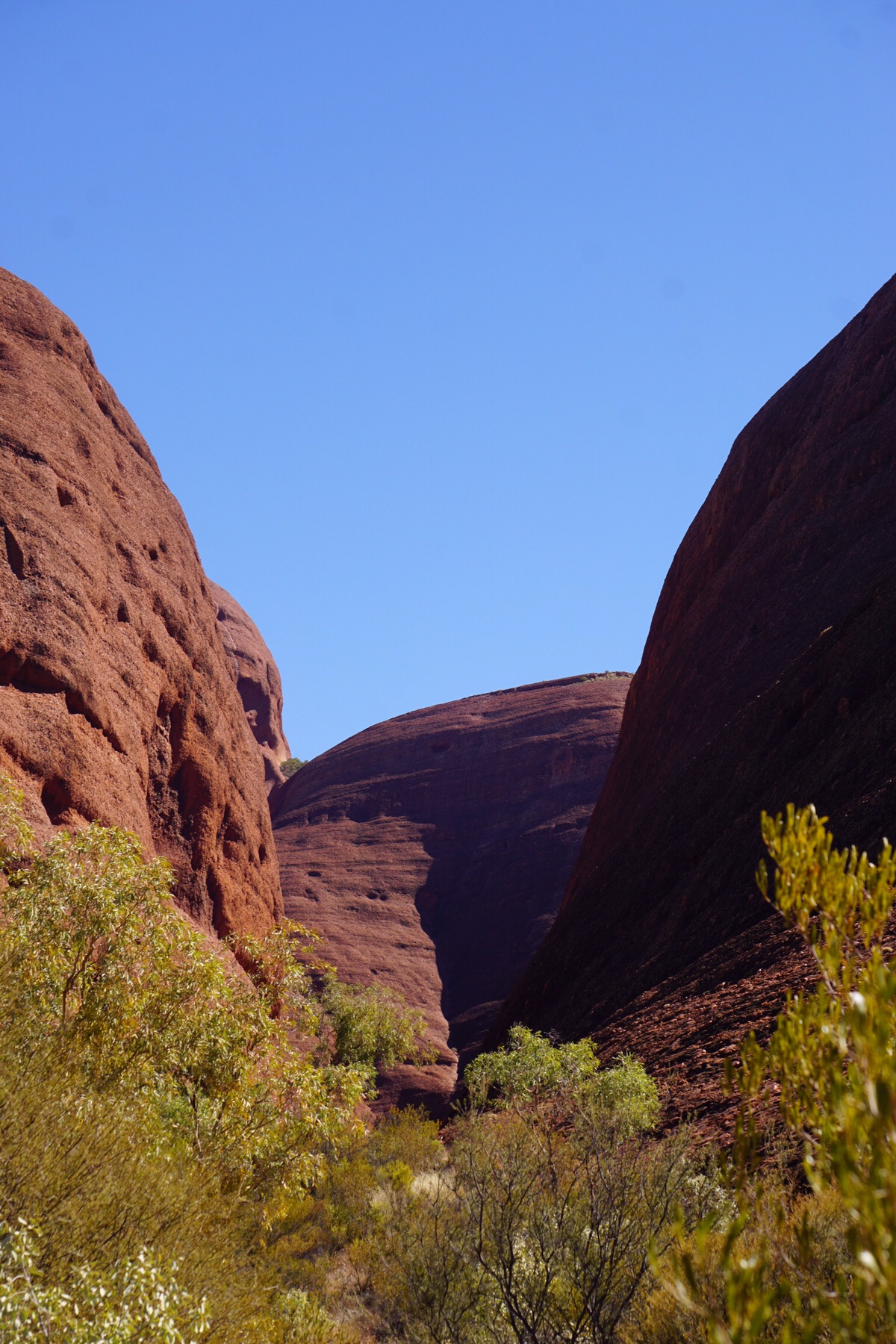
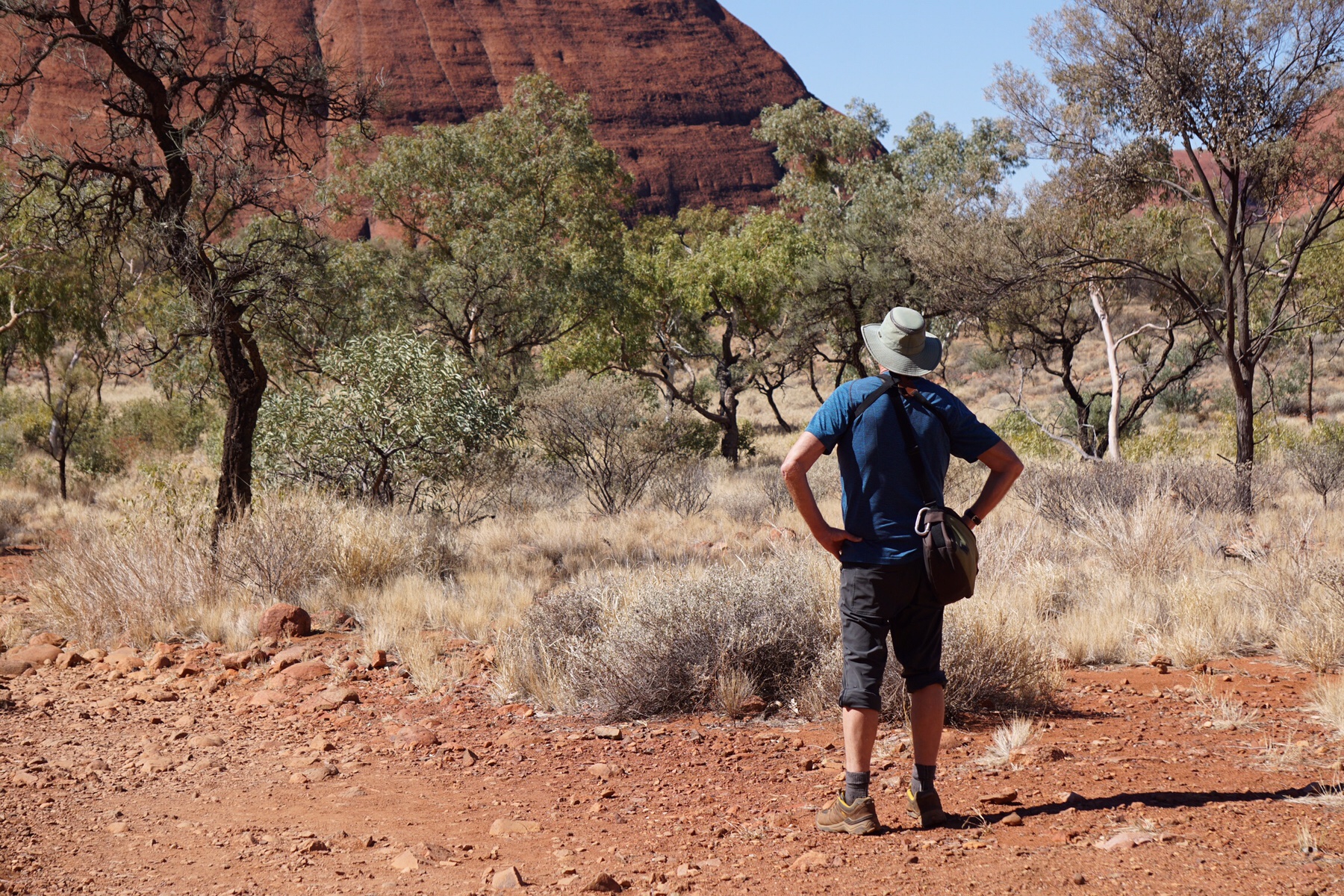 (Below, a friendly Grey Shrike-Thrush which accompanied us on our walk)
(Below, a friendly Grey Shrike-Thrush which accompanied us on our walk)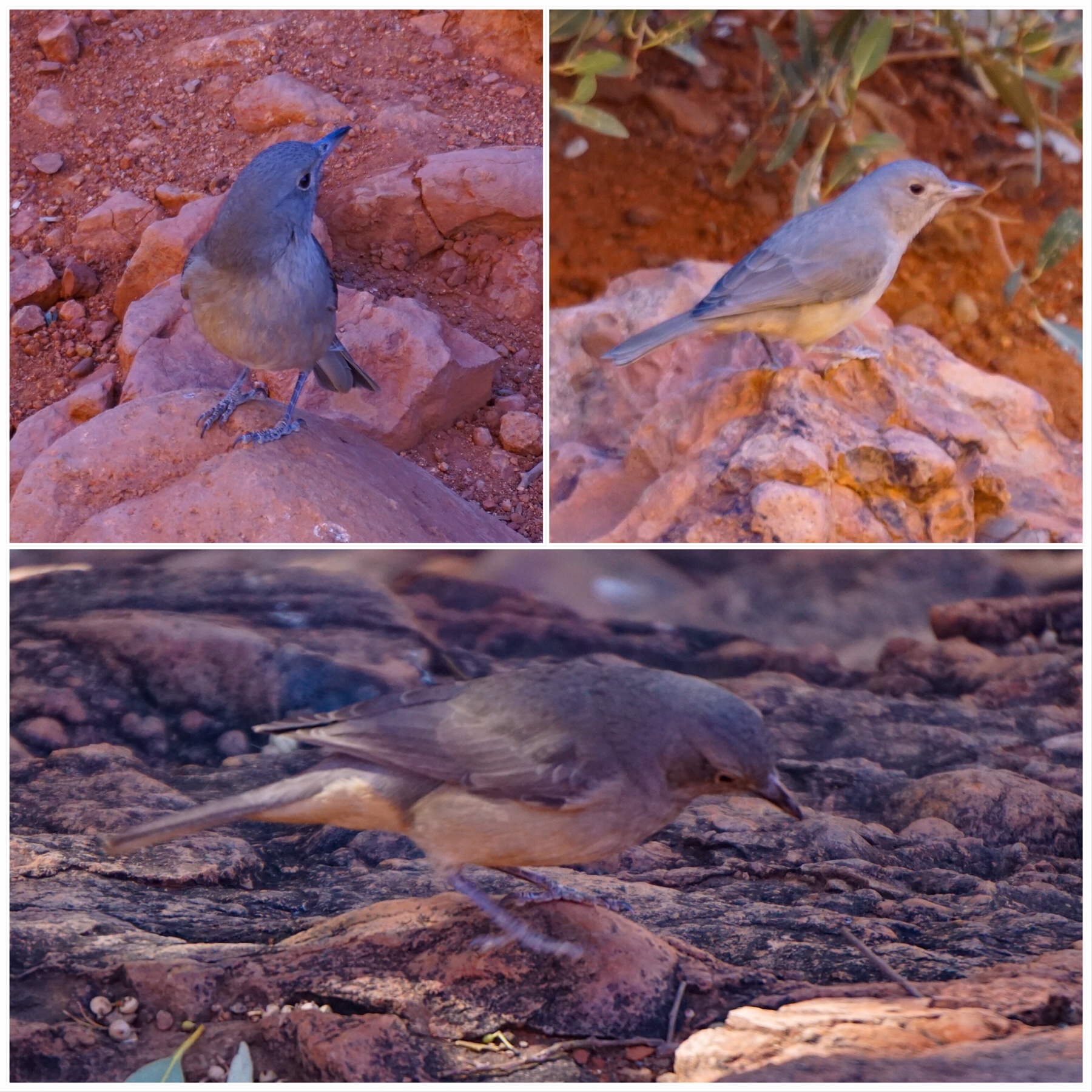 We could easily have spent a few more days here, but we are now on a bit of deadline, given we have lost a couple of weeks from our itinerary. So soon it was time to pack up and move on.
We could easily have spent a few more days here, but we are now on a bit of deadline, given we have lost a couple of weeks from our itinerary. So soon it was time to pack up and move on.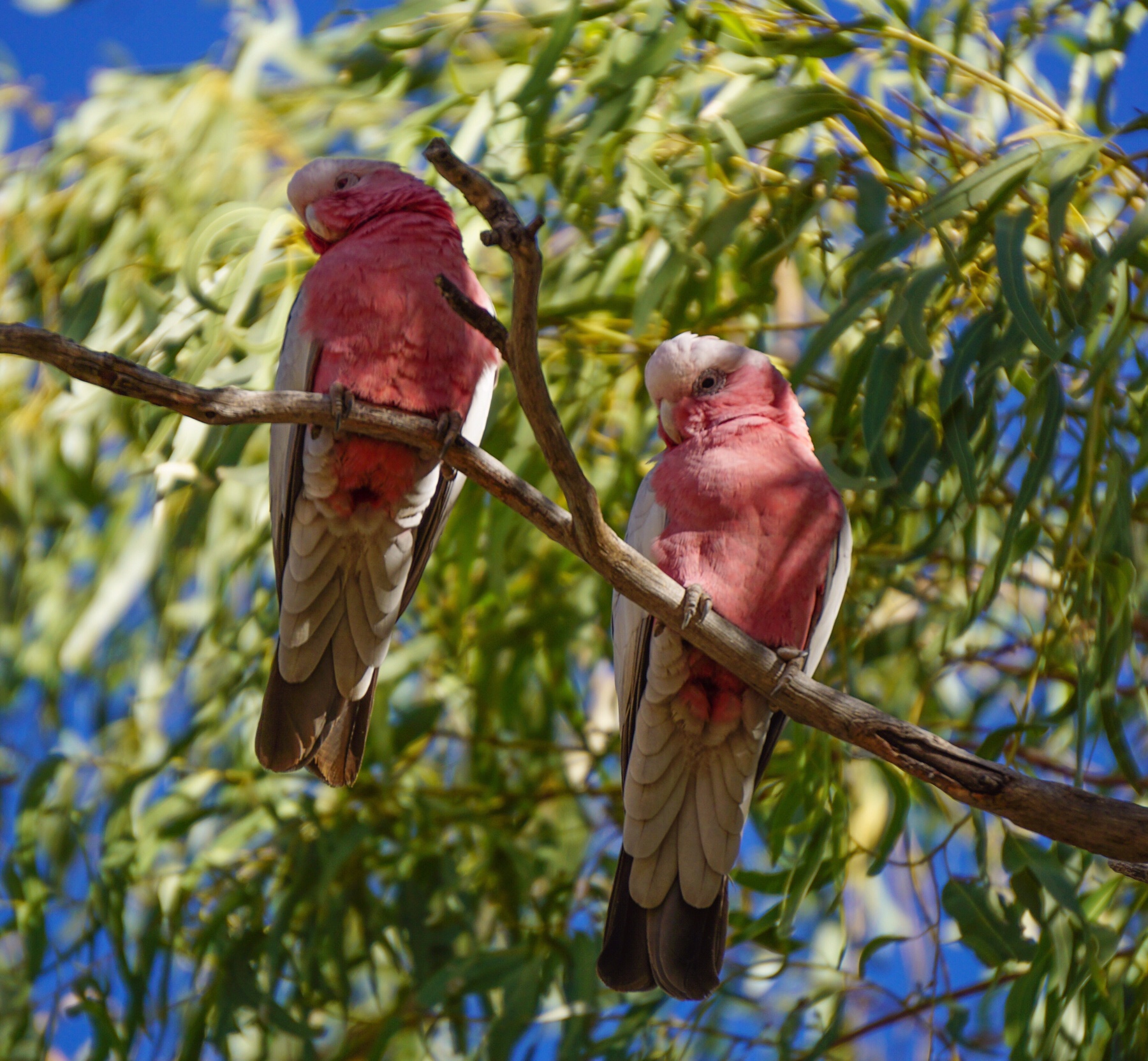
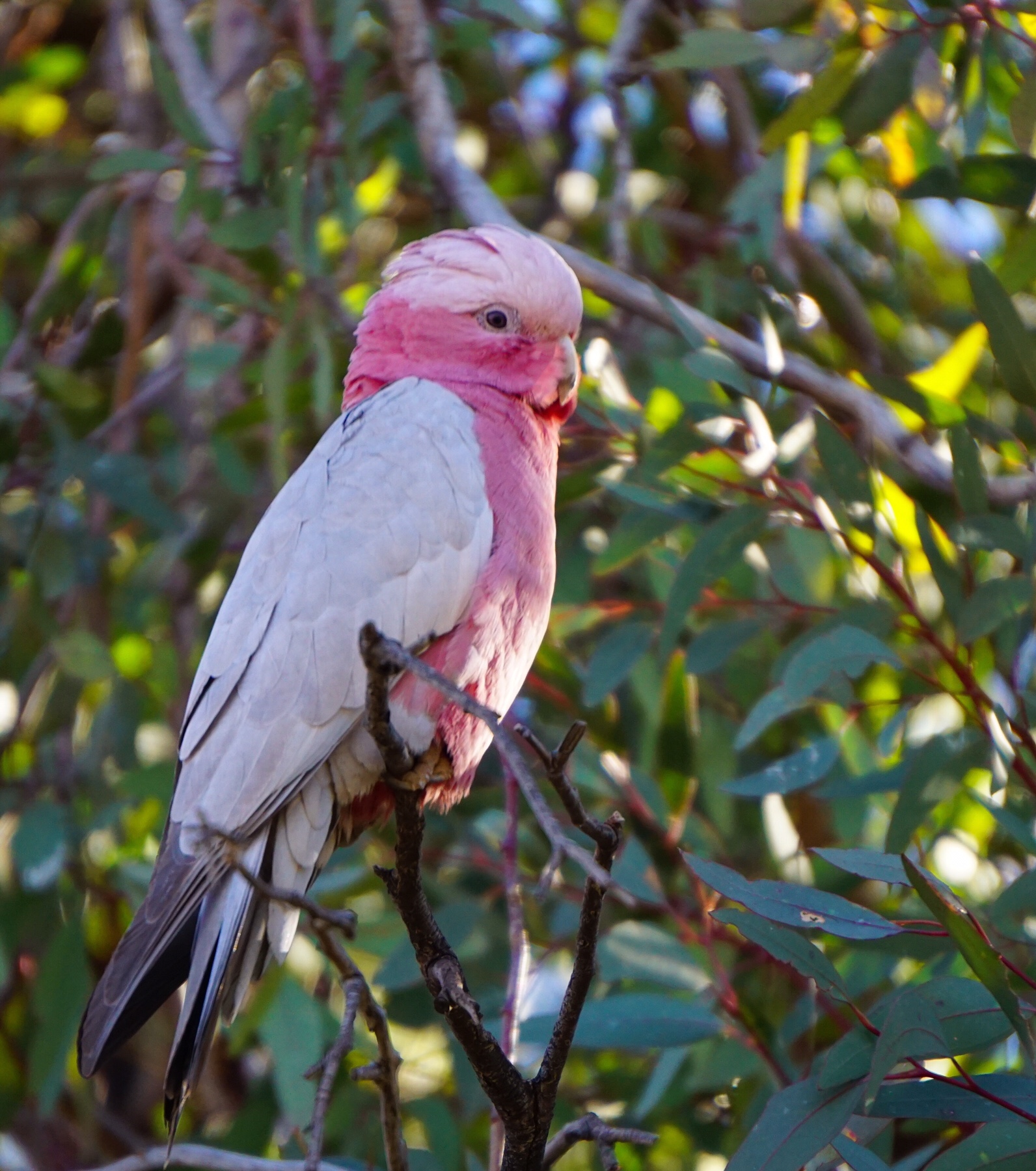
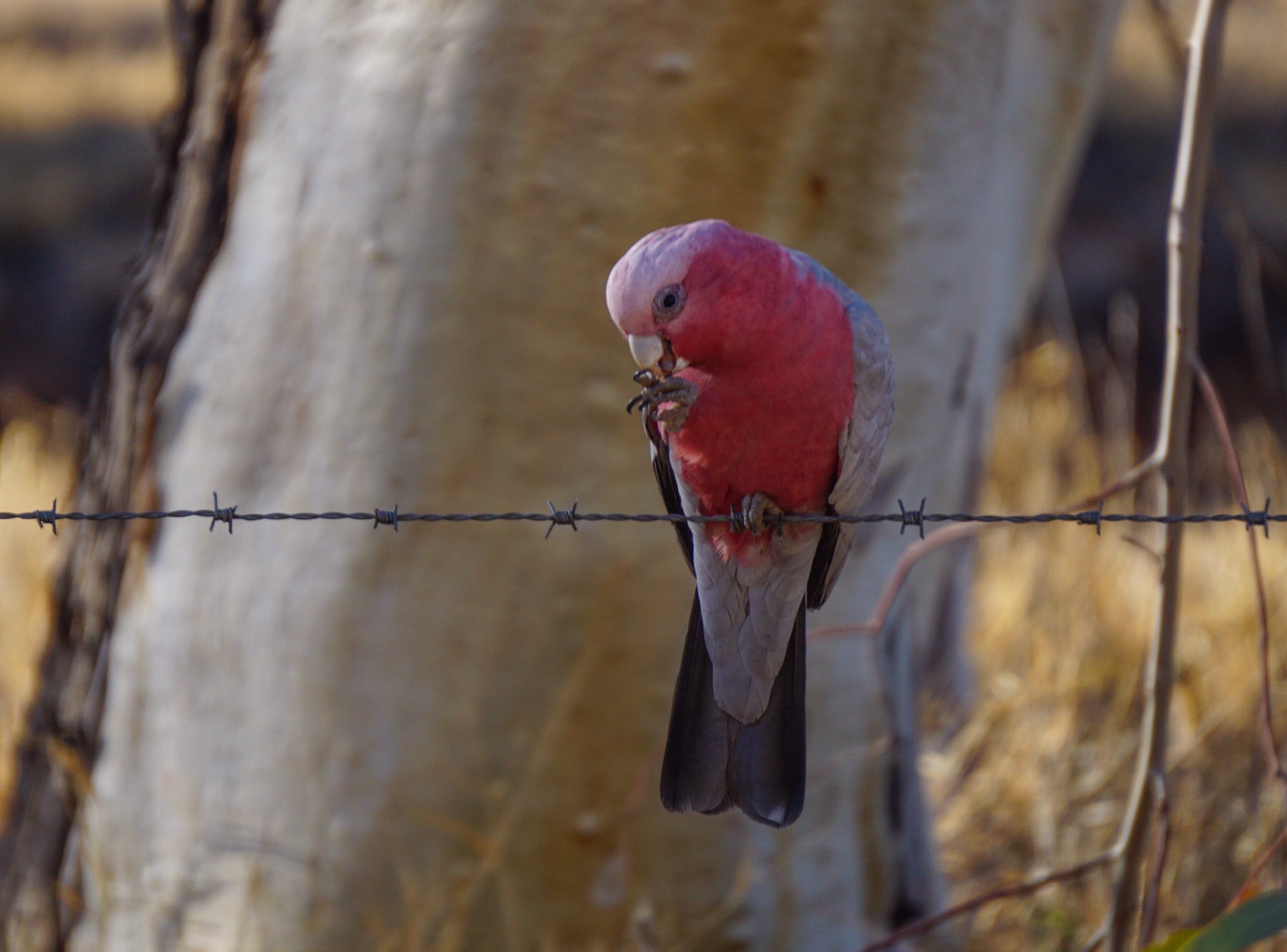 We had a nice stroll around admiring the scenery and enjoying the feeling of being upright!
We had a nice stroll around admiring the scenery and enjoying the feeling of being upright!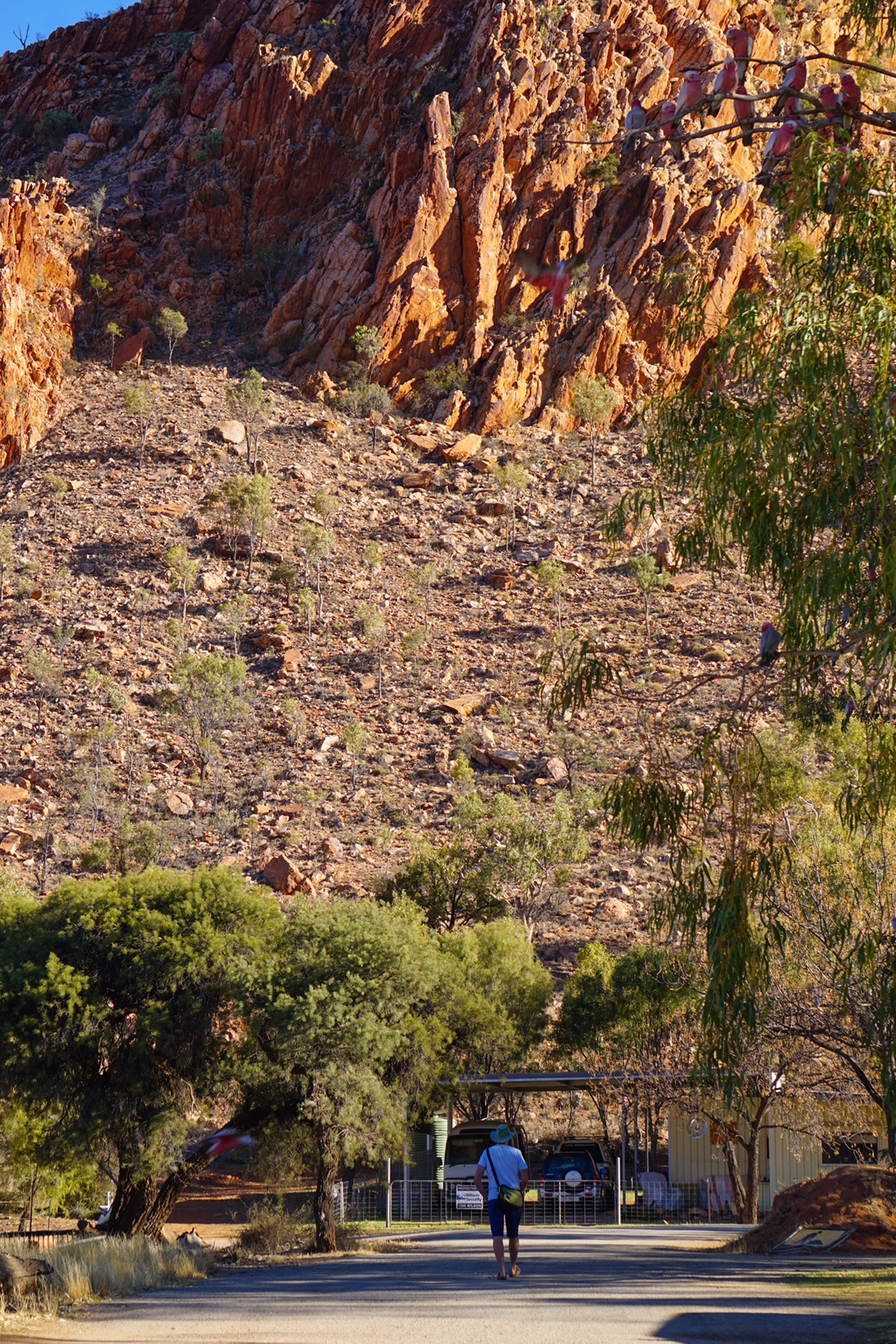 Sunday – location: Petermann
Sunday – location: Petermann